Nokia Solutions and Networks CPE25725 WiMAX CPE User Manual CPEi25725UM
Nokia Solutions and Networks WiMAX CPE CPEi25725UM
User Manual

Table
of
Contents
Contents
Chapter 1: Desktop CPEi 725 User Guide
Overview . . . . . . . . . . . . . . . . . . . . . . . . . . . . . . . . . . . . . . . . . . . . . . . . . . . . . . . . . . . . . . . . 1-1
Powerful Features in a Single Unit . . . . . . . . . . . . . . . . . . . . . . . . . . . . . . . . . . . . . . . . . . . . 1-1
Front of the CPE . . . . . . . . . . . . . . . . . . . . . . . . . . . . . . . . . . . . . . . . . . . . . . . . . . . . . . . . . . . 1-2
Back of the CPE . . . . . . . . . . . . . . . . . . . . . . . . . . . . . . . . . . . . . . . . . . . . . . . . . . . . . . . . . . . 1-2
Operating Information . . . . . . . . . . . . . . . . . . . . . . . . . . . . . . . . . . . . . . . . . . . . . . . . . . . . . . 1-3
Chapter 2: Installation
Overview . . . . . . . . . . . . . . . . . . . . . . . . . . . . . . . . . . . . . . . . . . . . . . . . . . . . . . . . . . . . . . . . 2-1
Before you Begin . . . . . . . . . . . . . . . . . . . . . . . . . . . . . . . . . . . . . . . . . . . . . . . . . . . . . . . . . . 2-1
Easy Setup . . . . . . . . . . . . . . . . . . . . . . . . . . . . . . . . . . . . . . . . . . . . . . . . . . . . . . . . . . . . . . . 2-1
Advanced Setup . . . . . . . . . . . . . . . . . . . . . . . . . . . . . . . . . . . . . . . . . . . . . . . . . . . . . . . . . . . 2-2
Procedure to Log into the CPE . . . . . . . . . . . . . . . . . . . . . . . . . . . . . . . . . . . . . . . . . . . . . . . . 2-2
Setup Wizard and Authentication . . . . . . . . . . . . . . . . . . . . . . . . . . . . . . . . . . . . . . . . . . . . . 2-3
Chapter 3: Basic Configuration
Personalize Menu . . . . . . . . . . . . . . . . . . . . . . . . . . . . . . . . . . . . . . . . . . . . . . . . . . . . . . . . . . 3-1
Password Tab . . . . . . . . . . . . . . . . . . . . . . . . . . . . . . . . . . . . . . . . . . . . . . . . . . . . . . . . . . . . . 3-2
Device Time Tab . . . . . . . . . . . . . . . . . . . . . . . . . . . . . . . . . . . . . . . . . . . . . . . . . . . . . . . . . . . 3-2
Device Name Tab . . . . . . . . . . . . . . . . . . . . . . . . . . . . . . . . . . . . . . . . . . . . . . . . . . . . . . . . . . 3-2
Restore Factory Settings Tab . . . . . . . . . . . . . . . . . . . . . . . . . . . . . . . . . . . . . . . . . . . . . . . . . 3-3
Internet Menu . . . . . . . . . . . . . . . . . . . . . . . . . . . . . . . . . . . . . . . . . . . . . . . . . . . . . . . . . . . . 3-3
WiMAX Security Tab . . . . . . . . . . . . . . . . . . . . . . . . . . . . . . . . . . . . . . . . . . . . . . . . . . . . . . . 3-4
Firewall Tab . . . . . . . . . . . . . . . . . . . . . . . . . . . . . . . . . . . . . . . . . . . . . . . . . . . . . . . . . . . . . . 3-4
Dynamic DNS Tab . . . . . . . . . . . . . . . . . . . . . . . . . . . . . . . . . . . . . . . . . . . . . . . . . . . . . . . . . 3-5
Status Menu . . . . . . . . . . . . . . . . . . . . . . . . . . . . . . . . . . . . . . . . . . . . . . . . . . . . . . . . . . . . . . 3-5
Telephony Menu . . . . . . . . . . . . . . . . . . . . . . . . . . . . . . . . . . . . . . . . . . . . . . . . . . . . . . . . . . . 3-6
Chapter 4: Advanced Configuration
Port Forwarding Menu . . . . . . . . . . . . . . . . . . . . . . . . . . . . . . . . . . . . . . . . . . . . . . . . . . . . . . 4-1
Forwarding Tab . . . . . . . . . . . . . . . . . . . . . . . . . . . . . . . . . . . . . . . . . . . . . . . . . . . . . . . . . . . 4-2
Local Address Menu . . . . . . . . . . . . . . . . . . . . . . . . . . . . . . . . . . . . . . . . . . . . . . . . . . . . . . . . 4-2
DHCP Server Tab . . . . . . . . . . . . . . . . . . . . . . . . . . . . . . . . . . . . . . . . . . . . . . . . . . . . . . . . . . 4-3
Lease Status Tab . . . . . . . . . . . . . . . . . . . . . . . . . . . . . . . . . . . . . . . . . . . . . . . . . . . . . . . . . . 4-4
Lease Reservation Tab . . . . . . . . . . . . . . . . . . . . . . . . . . . . . . . . . . . . . . . . . . . . . . . . . . . . . . 4-4
Control Panel . . . . . . . . . . . . . . . . . . . . . . . . . . . . . . . . . . . . . . . . . . . . . . . . . . . . . . . . . . . . . 4-5
Software Tab . . . . . . . . . . . . . . . . . . . . . . . . . . . . . . . . . . . . . . . . . . . . . . . . . . . . . . . . . . . . . 4-6
Certificate Tab . . . . . . . . . . . . . . . . . . . . . . . . . . . . . . . . . . . . . . . . . . . . . . . . . . . . . . . . . . . . 4-6
System Tab . . . . . . . . . . . . . . . . . . . . . . . . . . . . . . . . . . . . . . . . . . . . . . . . . . . . . . . . . . . . . . . 4-6
About Tab . . . . . . . . . . . . . . . . . . . . . . . . . . . . . . . . . . . . . . . . . . . . . . . . . . . . . . . . . . . . . . . . 4-7
Chapter 5: Configuring TCP/IP
Configuring TCP/IP in Windows 2000 . . . . . . . . . . . . . . . . . . . . . . . . . . . . . . . . . . . . . . . . . . 5-1
Configuring TCP/IP in Windows XP . . . . . . . . . . . . . . . . . . . . . . . . . . . . . . . . . . . . . . . . . . . . 5-5
Chapter 6: Troubleshooting
Power LED is Off . . . . . . . . . . . . . . . . . . . . . . . . . . . . . . . . . . . . . . . . . . . . . . . . . . . . . . . . . . 6-1
A Computer Cannot Log On to the CPE . . . . . . . . . . . . . . . . . . . . . . . . . . . . . . . . . . . . . . . . . 6-1
Cannot Connect to the Internet . . . . . . . . . . . . . . . . . . . . . . . . . . . . . . . . . . . . . . . . . . . . . . . 6-1
Additional Troubleshooting Help . . . . . . . . . . . . . . . . . . . . . . . . . . . . . . . . . . . . . . . . . . . . . . 6-1
Chapter 7: Important Safety and Legal Information
This Product complies with the following RF energy exposure standards and guidelines: . . 7-1
RF Exposure Compliance and Guidelines Operating Instructions . . . . . . . . . . . . . . . . . . . . . 7-1
FCC Regulatory Information . . . . . . . . . . . . . . . . . . . . . . . . . . . . . . . . . . . . . . . . . . . . . . . . . 7-1
Industry Canada Statement . . . . . . . . . . . . . . . . . . . . . . . . . . . . . . . . . . . . . . . . . . . . . . . . . . 7-2
EU Declaration of Conformity . . . . . . . . . . . . . . . . . . . . . . . . . . . . . . . . . . . . . . . . . . . . . . . . 7-3
Caring for the Environment . . . . . . . . . . . . . . . . . . . . . . . . . . . . . . . . . . . . . . . . . . . . . . . . . . 7-3
Disposal of Motorola Equipment in EU Countries . . . . . . . . . . . . . . . . . . . . . . . . . . . . . . . . . 7-4
Disposal of Motorola Networks Equipment in Non-EU countries . . . . . . . . . . . . . . . . . . . . . 7-4
CMM Disclosure . . . . . . . . . . . . . . . . . . . . . . . . . . . . . . . . . . . . . . . . . . . . . . . . . . . . . . . . . . . 7-4
Copyrights and Trademarks . . . . . . . . . . . . . . . . . . . . . . . . . . . . . . . . . . . . . . . . . . . . . . . . . . 7-5
Copyrights . . . . . . . . . . . . . . . . . . . . . . . . . . . . . . . . . . . . . . . . . . . . . . . . . . . . . . . . . . . . . . . 7-5
Usage and Disclosure Restrictions . . . . . . . . . . . . . . . . . . . . . . . . . . . . . . . . . . . . . . . . . . . . . 7-5
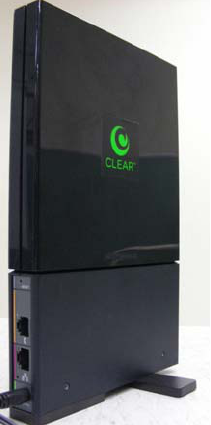
1-1
Desktop CPEi 725 User Guide 1
Chapter 1: Desktop CPEi 725 User Guide
Overview
Uibol!zpv!gps!qvsdibtjoh!uif! Npupspmb!DQF!Joepps!)DQFj*! 83 6!eftlupq!efwjdf/!Uif!
Eftlupq!DQFj!bmmpxt!zpv!up!dpoofdu!up!uif!xjsfmftt!xpsme!fbtjmz!boe!tfbnmfttmz!
xjuipvu!dpnqmjdbufe!jotubmmbujpo!boe!tfuvq!qspdfevsft/!Jo! beejujpo-!ju!pggfst!zpv!uif!
bcjmjuz!up!nblf!Wpjdf!pwfs!Joufsofu!Qspupdpm!)WpJQ*!dbmmt/
Uif!Eftlupq!DQF!joepps!)DQFj* !efwjdf!qspwjeft!uif!vtfs;
Ǹ Dpowfojfodf!.!xjui!fbtz!qmvh!boe! qmbz!gvodujpobmjuz/!Dpnqbdu!eftjho/
Ǹ Dpouspm!.!sfnpuf!nbobhfnfou!dbqbcjmjuz!bmmpxt!fbtz!efufdujpo!boe!bvuifoujdbujpo!
podf!uif!voju!jt!tfu!vq/!
Ǹ WpJQ!.!
Pof!SK22!qpsut!bmmpx!gps!Wpjdf!pwfs!JQ!dbmmt!vtjoh!zpvs!DQFj!836/
Uif!gfbuvsft!boe!uif!qiztjdbm !bqqfbsbodf!pg!zpvs!Eftlup q!DQFj!efwjdf!nbz!ejggfs!
tmjhiumz!gspn!uif!jmmvtusbujpo/!
Gjhvsf!2.2;! DQFj 836
Gps!uif!nptu!sfdfou!epdvnfoubujpo-!wj tju!uif!Qspevdu!Epdvnfoubujpo!qbhf!po!
xxx/npupspmb/dpn/
Powerful Features in a Single Unit
Uif!DQF!efwjdf!qspwjeft!uif!gpmmpxjoh!gfbuvsft;
Ǹ XjNBY!Bvuifoujdbujpo
Ǹ XBO!EIDQ!Dmjfou
Ǹ MBO!EIDQ!Tfswfs
Ǹ Ipnf!Hbufxbz!Gvodujpot
Ǹ Gjsfxbmm!Qspufdujpo
Ǹ Qpsu!Gpsxbsejoh
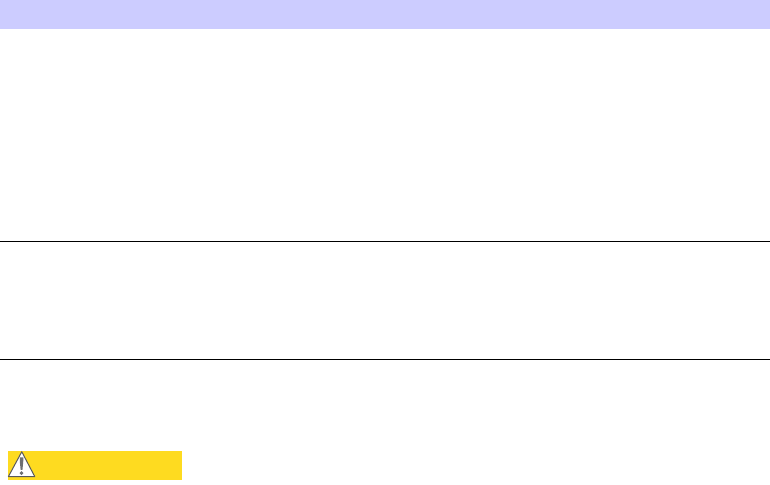
1-2
1Desktop CPEi 725 User Guide
Front of the CPE
The front of the CPE unit contains LED Link/Activity indicators. The LEDs provide the
status of the unit and signal strength indicators for easy adjustment during setup.
Back of the CPE
The back of the CPE unit contains the reset switch, AC Power Connector, Ethernet
connector, Ethernet LED and telephone port.
Table 1-1 LED Indicator Interface
LED Status
Signal Strength Full WiMAX Signal Strength is detected
when all WiMAX Signal Strength LEDs are
lit.
• All WiMAX Signal Strength LEDs are
off - very low signal detected.
• One to two WiMAX Signal Strength
LEDs are lit - low signal detected.
• Three to five WiMAX Signal Strength
LEDs are lit - high signal detected.
WAN WiMAX While acquiring access to the WiMAX
Network:
• All WiMAX Signal Strength LEDs vary
between ON, OFF and/or BLINKING
status.
If all five WiMAX Signal Strength LEDs are blinking, then a software up-
grade is in progress. Do NOT remove power to the CPE.
CAUTION
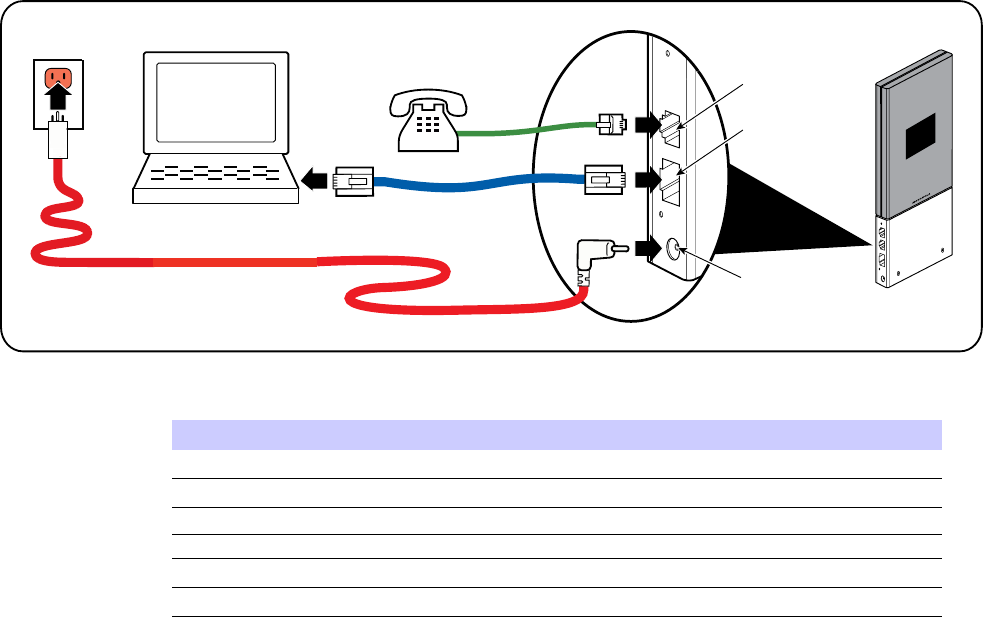
1-3
Desktop CPEi 725 User Guide 1
Gjhvsf!2.3;! DQF!Qpsut!boe!Dpoofdujpot
Operating Information
Pqfsbujoh!ufnqfsbuvsf!gps!uijt!voju!jt!1.51 °D!)43.215 °G*/
Table 1-2 Port Descriptions
Port Port Description
Fuifsofu Fuifsofu!Qpsu
Qpxfs BD!Qpxfs!Dpoofdups
Sftfu Ibsexbsf!Sftfu!Cvuupo!)B!qbqfsdmjq!jt!
sfdpnnfoefe!gps!bddfttjoh!uijt!cvuupo*/
Qipof!Mjof! SK.22!qpsu!gps!vtf!xjui!WpJQ/
Qipof!2!)WpJQ*
BD!Qpxfs
Dpoofdups
Bebqufs
Dpnqvufs
DQF j836
Fuifsofu
Dpoofdups
1-4
1Desktop CPEi 725 User Guide

2-1
Installation 2
Chapter 2: Installation
Overview
To install the Desktop CPEi 725 Series, review the following sections:
• Before You Begin
•Easy Setup
Before you Begin
Before you begin installation, check that you have received the following items with
your Desktop CPEi 725:
In addition, you need:
• A computer
• An RJ-11 telephone cable (optional). Two RJ-11 telephone cables are required if
your service provider has supplied you with two telephone numbers.
Easy Setup
The CPE is easily set up in your home. Basic installation equipment needed are the
power adapter and cord, Ethernet cable, a PC or laptop computer and the CPE device.
If you want to use the VoIP functionality, you need an RJ-11 phone cable and a
telephone.
Perform the following tasks before attaching the power cord or powering up the unit:
• Stand the CPE on a flat surface.
• Plug the power adapter into the power connector on the back of the unit.
• Plug the AC power cord into an AC outlet.
• Plug one end of the Ethernet cable into the Ethernet connector on the back of the
unit.
• Plug the other end of the Ethernet cable into the Ethernet connector of your
computer.
• To use VoIP functionality of the phone, plug one end of the phone line into the
activated phone connector on the back of the unit. Phone line activation is
dependent upon your service contract.
• Plug the other end of the phone line into the phone line connector of your
telephone.
Table 2-1 In the box with your CPE, you should have
Item Description
AC Adapter Power adapter and cord connects the
Desktop CPE to an AC electrical outlet.
Ethernet Cable The Ethernet cable connects the Internet
port on your Desktop CPE to your PC or
laptop computer.
Desktop CPEi 725 Quick Start Guide Desktop CPEi 725 Quick Start Guide

2-2
2Installation
Advanced Setup
The CPE can also be used to connect to a multi-port switch (hub) - purchased
separately from the CPE. Connecting the CPE device to a hub allows you to connect
more than one computer to your CPE device.
Procedure to Log into the CPE
Before you Begin Configuration
Some settings on your computer need to be verified or changed to ensure that your
computer configuration can support the Desktop CPE.
Verify that the IP addresses and DNS settings are automatically generated in your
Local Area connection of your Internet Protocol (TCP/IP) properties. Refer to the
chapter titled “Configuring TCP/IP” for additional information.
Logging in to the CPE
Use the following procedure to log into the Desktop CPE:
1. On a computer that is connected to the Desktop CPE, open a web browser.
2. In the Address or Location field, type http://mywimax. and press ENTER to
display the login screen.
Include the period (.) after http://mywimax. in order to access the login screen.
3. The Welcome to Motorola WiMAX CPE screen is displayed and prompts you for a
password.
Enter the IP address: http://192.168.15.1 into Address field in order to gain
access to your CPE. If you cannot access the CPE, refer to the chapter
titled: Configuring TCP/IP for more information.
NOTE
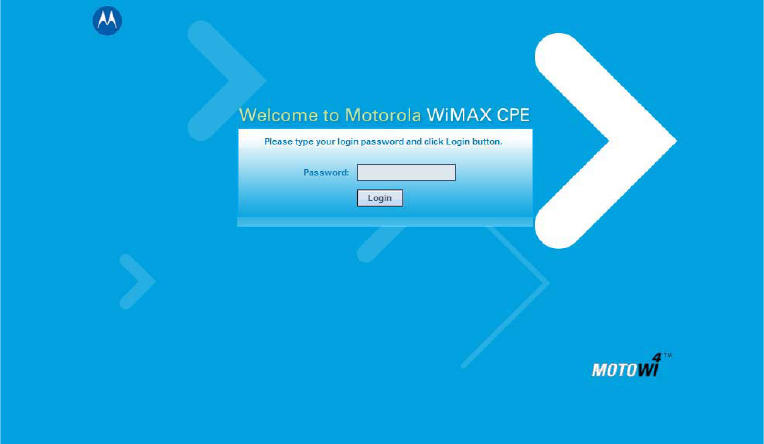
2-3
Installation 2
Figure 2-1: Login Screen
4. In the Password field, type the password (default is motorola).
5. Click Login.
6. First time users see a pop-up box that states: “The Wizard application will guide
you through for the first time configuration”. Click OK button to continue.
7. Click the OK button to launch the wizard application.
Setup Wizard and Authentication
Step 1 - Change Password
Once you have launched the setup wizard, you are prompted to change your password.
Motorola recommends using a password to protect your home network and CPE
device. Passwords are case sensitive.
To change your password:
• Ensure the “Enable Login Password Protection” box is checked.
• Enter a New Login Password in the box. Passwords can be no more than 20
characters in length.
• Re-type your new password in the Confirm New Login Password box.
• Click Next.
If you forget your password, you can reset it back to the default (motorola) password.
To reset the password, press and hold the reset button on the back of your CPE for 5 or
more seconds. Before resetting the CPE, ensure that the power is ON.
Step 2 - Device Time
This screen allows you to set the time zone and to enable Daylight Savings Time (when
applicable) for your location.
• Select the appropriate time zone for your location from the drop-down box.
2-4
2Installation
• Check the box that is called “Auto Adjust for Daylight Savings Time” if you live in a
region that observes Daylight Savings Time. This box is checked by default.
• Click the Next button.
Step 3 - WiMAX Security
The WiMAX Security tab contains your authentication method. Check with your
service provider to determine if they require a user name and password for
authentication purposes.
• If the Authentication Method is EAP-TLS, no User Name and Password are
required. Enter the Realm information supplied by your service provider. Click the
Next button.
• If the Authentication Method is EAP-TTLS/MS-CHAPv2, enter a User Name and
Password, and Realm information supplied by your Service Provider. Once you have
entered the User Name/Password/Realm information, click the Next button.
• If you are unsure of the Authentication Method, select EAP-TLS (which is the
default) and click the Next button.
Step 4 - Account
The Account tab allows you to manage Voice over IP (VoIP) related services. Please
consult with your telephony service provider for these settings.
Click the Apply button when finished.
Congratulations! You have now completed the setup of your WiMAX connection.
Click OK on the Congratulations! dialog box.
A status screen appears that shows Network status and telephony status. The Network
Status screen provides any status associated with your WiMAX Wireless Broadband
connection. The Telephony Status screen provides status of your telephony service.
•The Restart button is used to restart the device. The restart button is available on
every screen.
•The Wizard button starts the set-up wizard over again.
•The Refresh button refreshes the screen with the current status.
•The Auto Refresh button allows the web browser to automatically refresh at the
interval determined in the Control Panel menu.
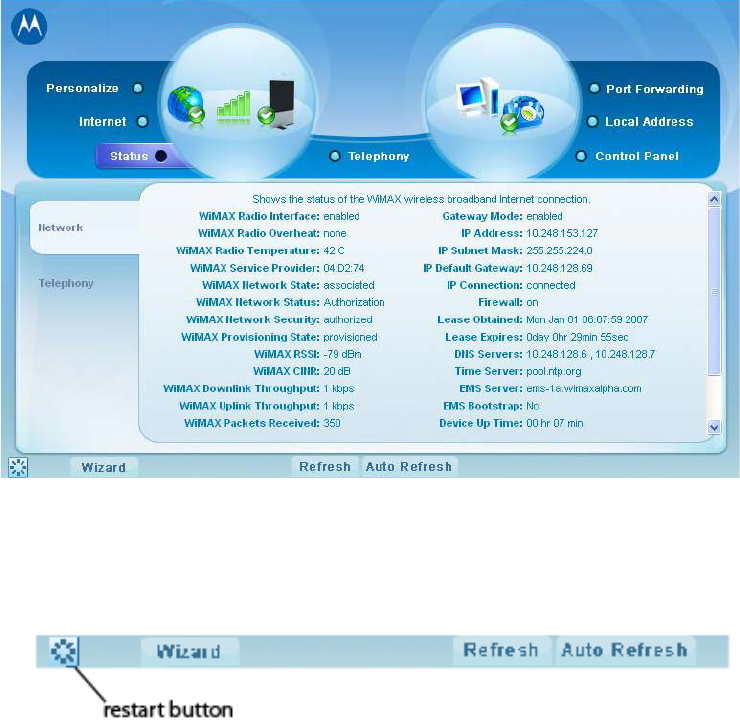
2-5
Installation 2
Figure 2-2: Status Screen
Restart Button
Figure 2-3: Restart Button
2-6 68P09292A81-B
JUN 2008
2Installation
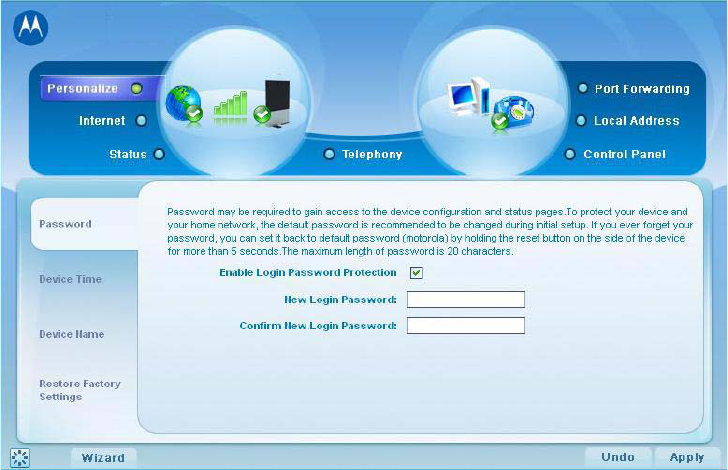
3-1
Basic Configuration 3
Chapter 3: Basic Configuration
Once the CPE setup has been completed, you can log in to your CPE from any
computer on your home network. To log in type the device name in the address bar on
your computer. The default device name is mywimax.
This section describes the PERSONALIZE, INTERNET, and STATUS Menus that are
available.
Personalize Menu
The Personalize menu provides the following tabs:
• Password
• Device Time
• Device Name
• Restore Factory Settings
Figure 3-1: Personalize Menu
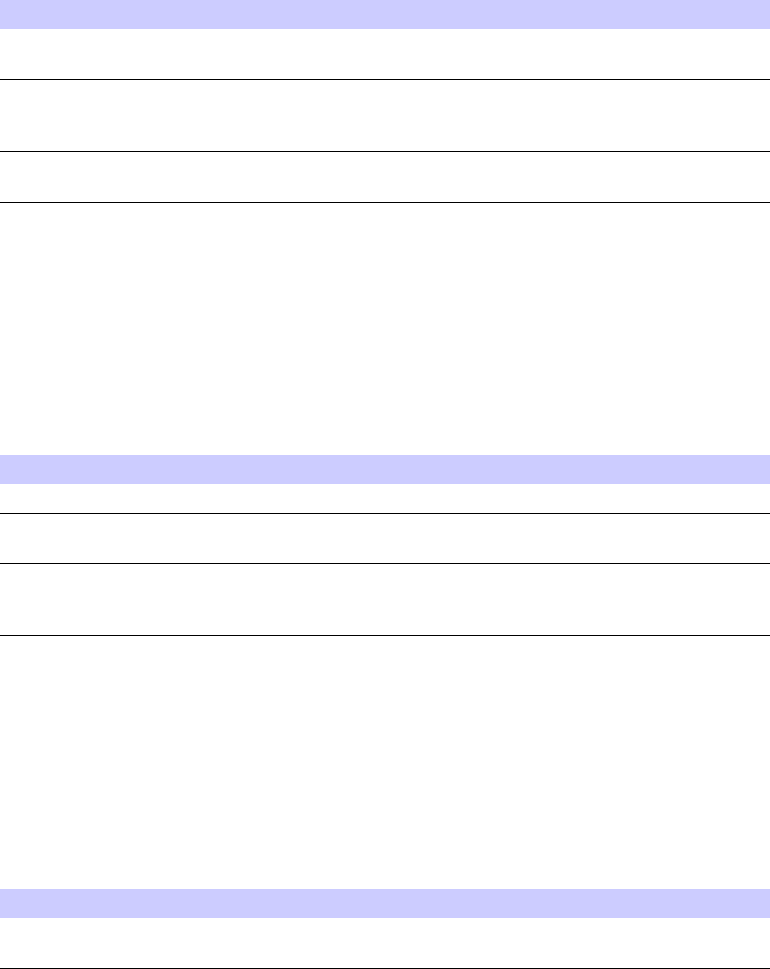
3-2
3Basic Configuration
Password Tab
The password tab allows you to enable/disable password protection. You can also
change your password here. Be sure to click the Apply button when finished
.
Device Time Tab
The Device Time tab allows you to establish the time zone for your location. It also
allows you to automatically adjust for Daylight Savings Time if necessary. Be sure to
click the Apply button when finished.
Device Name Tab
The Device Name tab allows you to rename your CPE device. The Device Name is the
name you enter on an internet browser address bar to access your CPE device. Be sure
to click the Apply button when finished.
Table 3-1 Password Tab
Field or Button Description
Enable Login Password Protection Checking this box requires login password
protection.
New Login Password Enter your new password here. Maximum
20 characters. Passwords are case
sensitive.
Confirm New Login Password Re-enter your new password here, exactly
as entered in the previous step.
Table 3-2 Device Time Tab
Field or Button Description
Current Local Time Current Local Time
Time Zone Select your local time zone from the drop-
down box.
Auto Adjust for Daylight Saving Time Check this box if your location observes
Daylight Savings Time. (Default is
checked)
Table 3-3 Device Name Tab
Field or Button Description
New Device Name Enter the new name for the CPE device.
Maximum 20 characters.
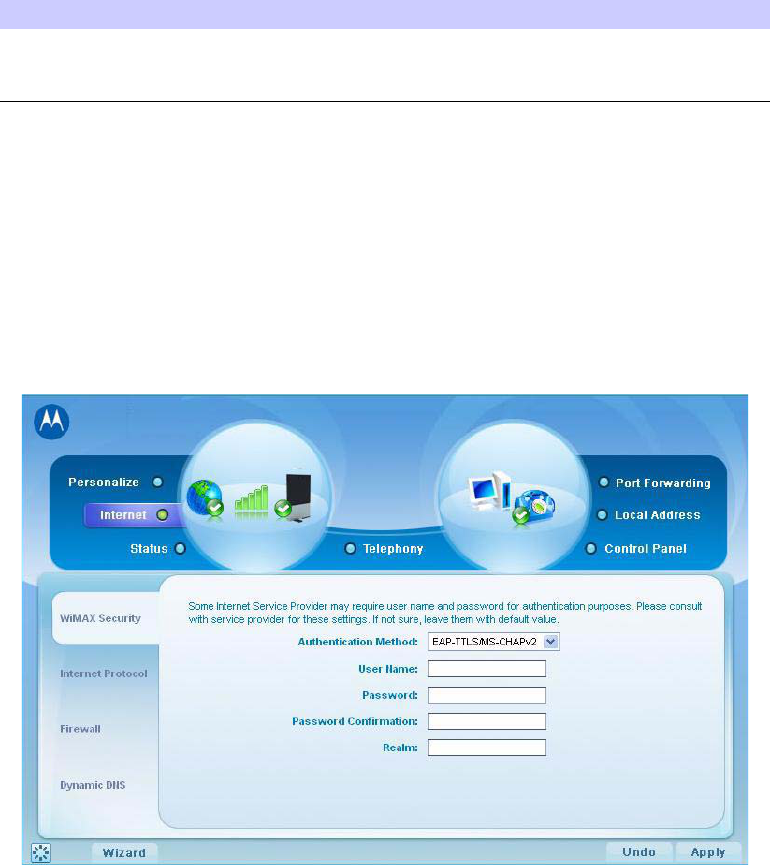
3-3
Basic Configuration 3
Restore Factory Settings Tab
The Restore Factory Settings Tab resets your CPE to the manufacturers default
settings. Be sure to click the Apply button if you are sure that you want to reset
factory settings.
Internet Menu
The Internet menu provides the following tabs:
• WiMAX Security
• Internet Protocol
•Firewall
• Dynamic DNS
Figure 3-2: Internet Menu
Table 3-4 Restore Factory Settings Tab
Field or Button Description
Restore Factory Settings Checking this box restores the CPE to
factory default settings. The device
restarts when you click Apply.
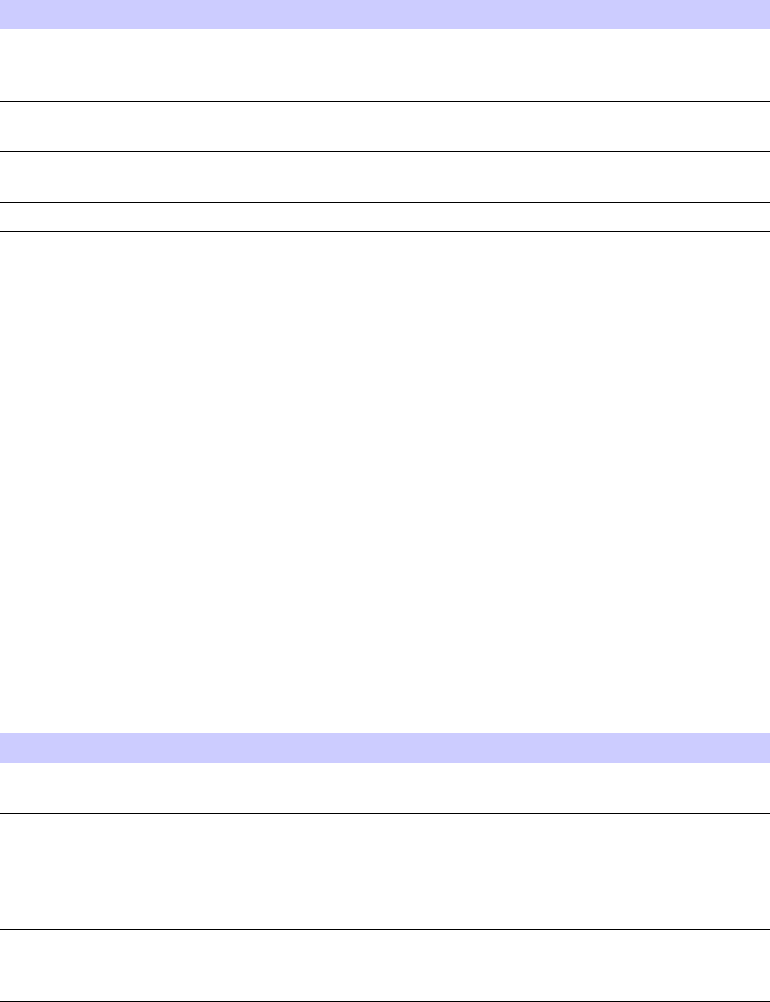
3-4
3Basic Configuration
WiMAX Security Tab
The WiMAX Security tab contains your authentication method. Check with your
service provider to determine a user name and password are required for
authentication purposes.
If your authentication method is EAP-TLS, then a User Name and Password are not
necessary.
Click the Apply button.
Internet Protocol Tab
Please check with your service provider for these settings. If you are unsure of the
settings, leave the default values set and click the Apply button.
If your service provider has instructed you to change any of these settings, be sure to
click the Apply button when you are finished.
Firewall Tab
A firewall helps to protect your home network from unauthorized access. It also helps
to manage authorized access from the internet to your CPE.
Table 3-5 WiMAX Security Tab
Field or Button Description
Authentication Method Drop down box allows you to select either
EAP-TLS (default) or EAP-TTLS/MS-
CHAPv2.
User Name (EAP-TTLS/MS-CHAPv2 only) Enter the User Name supplied by your
service provider.
Password (EAP-TTLS/MS-CHAPv2 only) Enter the Password supplied by your
service provider.
Realm Supplied by your service provider.
Table 3-6 Firewall Tab
Field or Button Description
Enable Firewall Check this box to enable the firewall for
your home network.
Enable Web Login from Internet (Grayed out if Enable Firewall is not
selected).
Check this box to enables you to access
your CPE device from a network other
than your own.
Web Login Port from Internet Choose a port number to connect to when
logging in from a network other than your
own. The default is 8080.
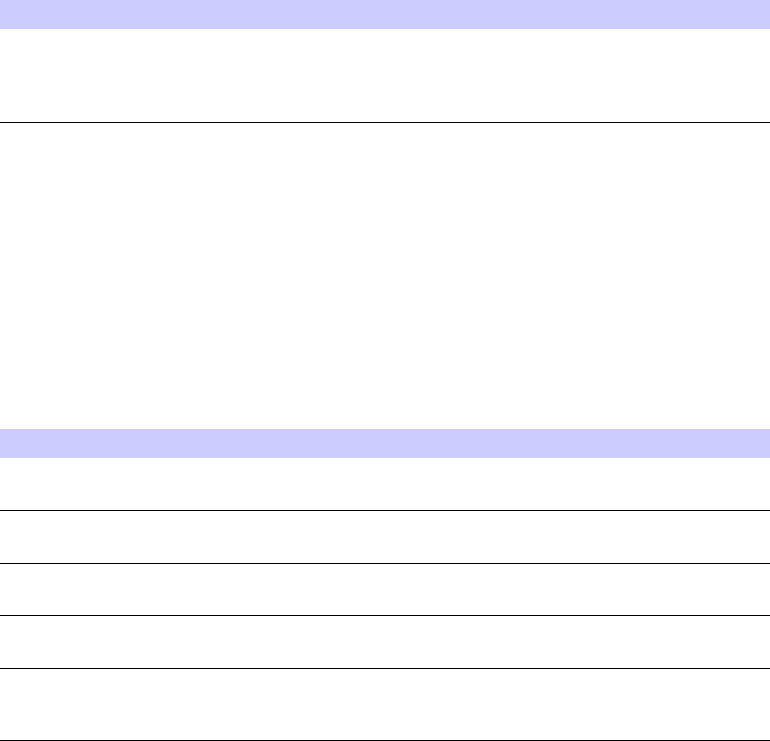
3-5
Basic Configuration 3
Be sure to click the Apply button once you are finished.
Dynamic DNS Tab
Dynamic Domain Name Service (DDNS) allows a user with a non-static IP address to
keep their domain name associated with an ever changing IP address. As an example,
DDNS is used when you are hosting your own website.
Be sure to click the Apply button once you are finished.
Status Menu
The Status menu provides the following tabs:
•Network
•Telephony
Enable ping from Internet Enables the CPE to respond to a ping from
the Internet. This option would be enabled
to allow testing only. Do not leave this
enabled.
Table 3-6 Firewall Tab
Field or Button Description
Table 3-7 Dynamic DNS Tab
Field or Button Description
Enable DDNS Check this box to Enable DDNS (default is
unchecked).
DDNS Service Provider Select DDNS Service Provider that you
belong to from the drop-down box.
DDNS User Name Only valid if Enable DDNS is checked.
Enter your DDNS account user name.
DDNS Password Only valid if Enable DDNS is checked.
Enter your DDNS account password.
DDNS Host Name Only valid if Enable DDNS is checked.
Enter the DDNS Host Name. This is
assigned by the DDNS service.
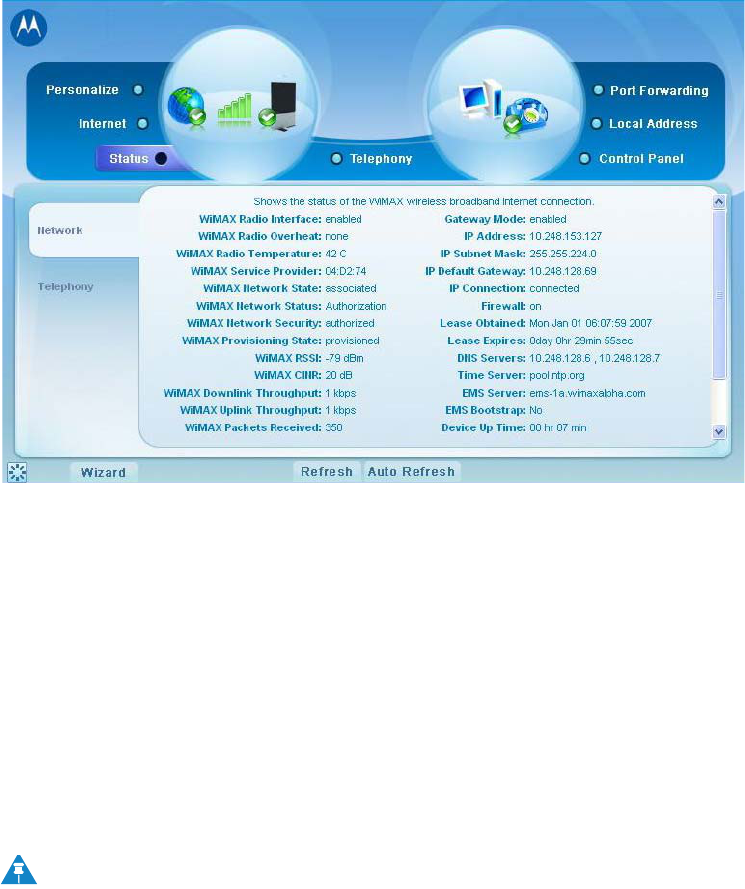
3-6
3Basic Configuration
Figure 3-3: Status Menu
Network Tab
The Network tab provides any status associated with your WiMAX Wireless Broadband
connection.
Telephony Tab
The Telephony tab provides any status associated with your telephony connection.
Telephony Menu
The telephony menu allows you to manage your Voice over Internet Protocol (VoIP)
services.
The Telephony menu provides the following tabs:
• Account
• Ring Tone
• Caller ID
• Call Forwarding
• Voice Mail
• Special Numbers
Contact your service provider to obtain VoIP service, if you do not already
have this service
.
NOTE
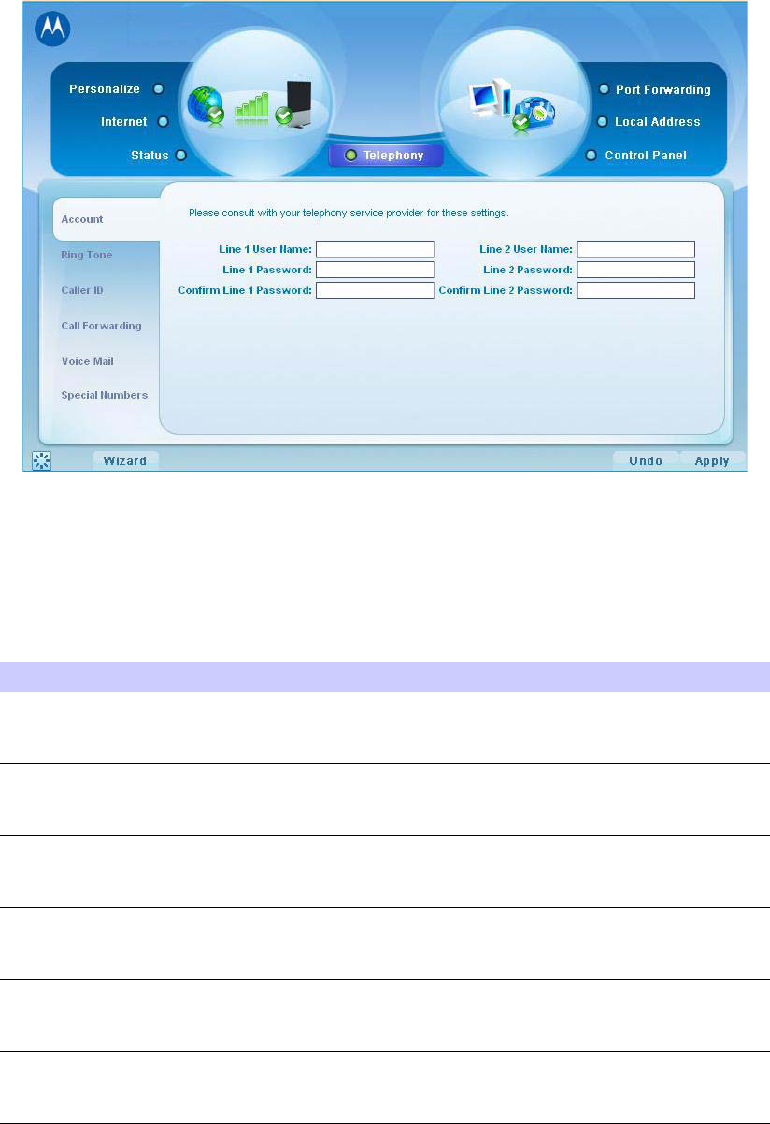
3-7
Basic Configuration 3
Figure 3-4: Telephony Menu
Account Tab
Please consult with your service provider for these settings. The Account Tab contains
the following settings:
Table 3-8 Account Tab
Field or Button Description
Line 1 User Name If Line 1 is an active VoIP, enter the User
Name as provided by your service
provider.
Line 1 Password Enter the Line 1 password as provided by
your service provider. Passwords are case
sensitive.
Confirm Line 1 Password Reenter your Line 1 password exactly as
entered in the field from the previous
step.
Line 2 User Name If Line 2 is an active VoIP, enter the User
Name as provided by your service
provider.
Line 2 Password Enter the Line 2 password as provided by
your service provider. Passwords are case
sensitive.
Confirm Line 2 Password Re-enter your Line 2 password exactly as
entered in the field from the previous
step.
Be sure to click the Apply button once you have made changes.
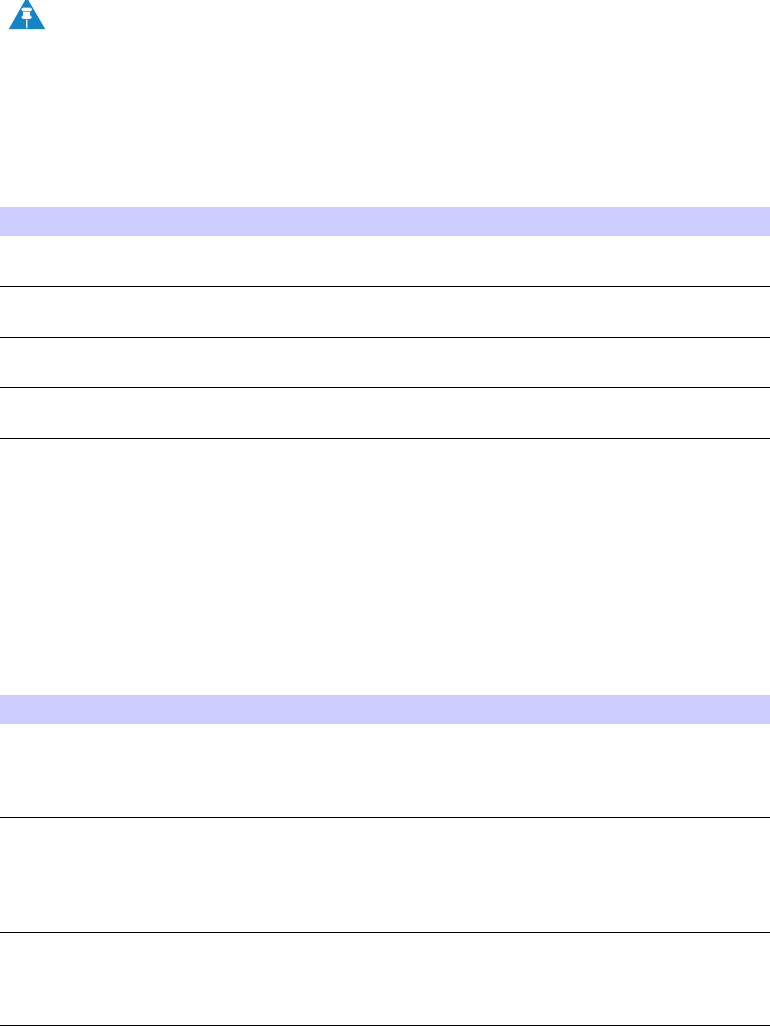
3-8
3Basic Configuration
Ring Tone Tab
The Ring Tone tab allows you to customize ring tones for your telephone(s).
Be sure to click the Apply button once you have made changes.
Caller ID Tab
The Caller ID tab allows you to manage the Caller ID functions for your telephones:
You need a phone connected to your CPE to hear ring tones.
Table 3-9 Ring Tone Tab
Field or Button Description
Default Line 1 Ring Type Use the drop-down box to select a ring
tone for Line 1. The default is ringtone R0.
Test Click to hear how the selected ring tone
sounds.
Default Line 2 Ring Type Use the drop-down box to select a ring
tone for Line 2. The default is ringtone R0.
Test Click to hear how the selected ring tone
sounds.
NOTE
Table 3-10 Caller ID Tab
Field or Button Description
Enable Line 1 Anonymous Incoming Call
Rejection
If Line 1 is your active telephone port,
check this box if you would like to reject
telephone calls from anonymous incoming
callers. The default is checked.
Enable Line 1 Permanent Anonymous
Outgoing Call
If Line 1 is your active telephone port,
check this box if you would like to
permanently block your telephone number
from appearing on others’ Caller ID. The
default is unchecked.
Enable Line 2 Anonymous Incoming Call
Rejection
If Line 2 is your active telephone port,
check this box if you would like to reject
telephone calls from anonymous incoming
callers. The default is checked.
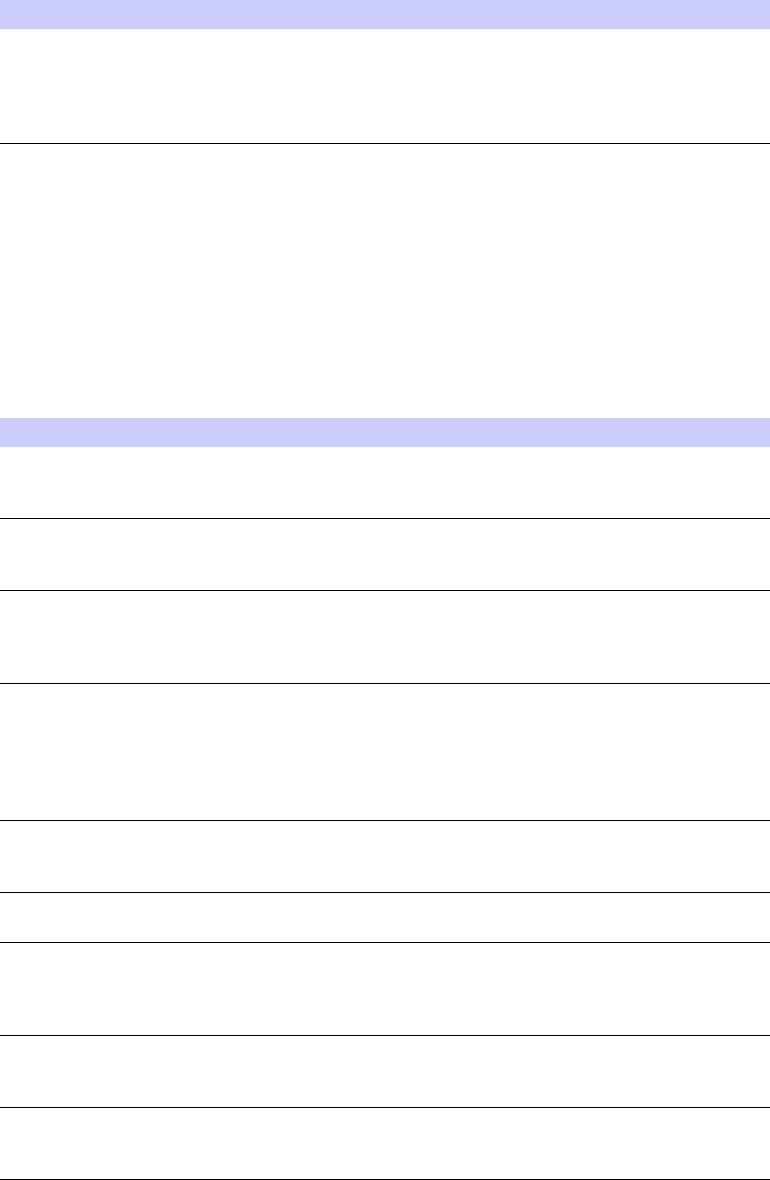
3-9
Basic Configuration 3
Be sure to click the Apply button once you have made changes.
Call Forwarding Tab
The Call Forwarding tab allows you to manage the call forwarding features for your
telephone(s). The Call Forwarding tab contains the following:
Enable Line 2 Permanent Anonymous
Outgoing Call
If Line 2 is your active telephone port,
check this box if you would like to
permanently block your telephone number
from appearing on others’ Caller ID. The
default is unchecked.
Table 3-10 Caller ID Tab
Field or Button Description
Table 3-11 Call Forwarding Tab
Field or Button Description
Enable Line 1 Basic Forwarding Check this box to enable basic call
forwarding on Line 1. The default is
unchecked.
Line 1 Basic Forwarding to Number If “Enable Line 1 Basic Forwarding” is
checked, enter the telephone number you
would like to forward calls to.
Enable Line 1 Forwarding on No Answer Check this box to forward calls received
on Line 1 if there is no answer. This
function is not available if “Enable Line 1
Basic Forwarding” is checked.
Line 1 No Answer Forwarding to Number If “Line 1 No Answer Forwarding to
Number” is checked, enter the telephone
number you would like to forward calls to
when there is no answer on Line 1. This
function is not available if “Enable Line 1
Basic Forwarding” is checked.
Line 1 No Answer Forwarding Ring Count Enter the number of rings allowed before
the call forwards to the number identified
above. The default is six rings.
Enable Line 1 Forwarding on Busy Check this box to forward calls received
while Line 1 is in use.
Line 1 Busy Forwarding To Number If “Enable Line 1 Forwarding on Busy” is
checked, enter the telephone number you
would like calls forwarded to when Line 1
is in use.
Enable Line 2 Basic Forwarding Check this box to enable basic call
forwarding on Line 2. The default is
unchecked.
Line 2 Basic Forwarding to Number If “Enable Line 2 Basic Forwarding” is
checked, enter the telephone number you
would like to forward calls to.
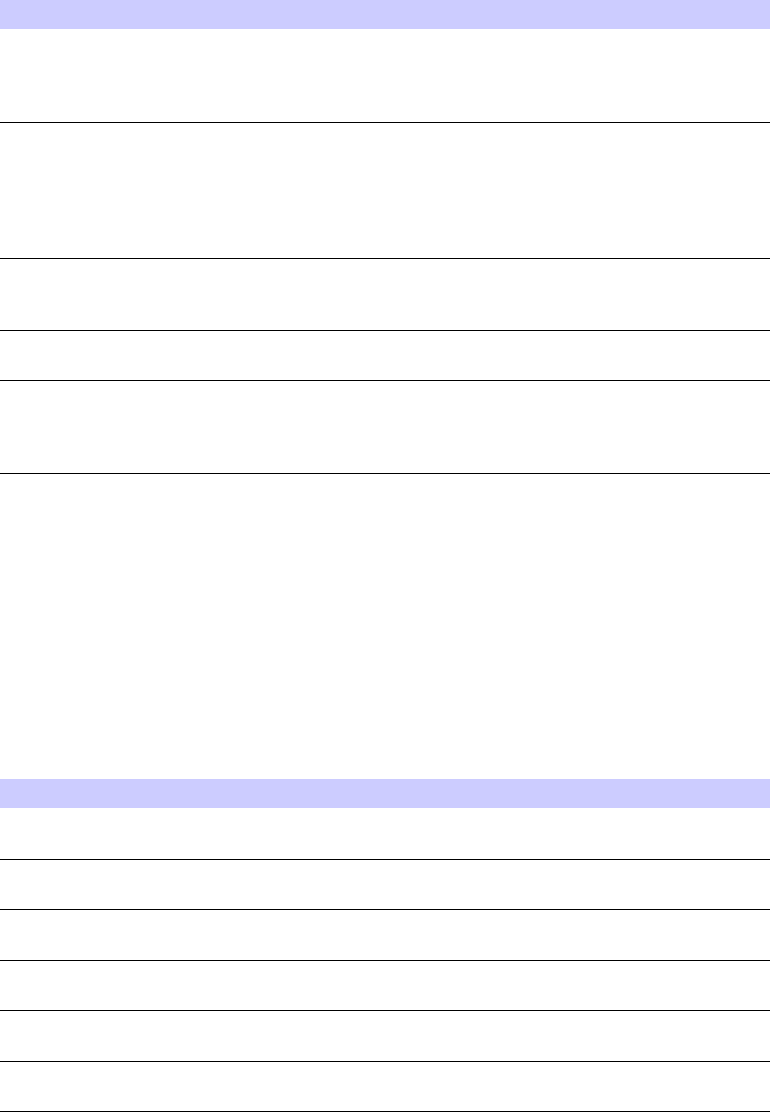
3-10
3Basic Configuration
Be sure to click the Apply button once you have made changes.
Voice Mail Tab
The voice mail tab allows you to see the status of your voice mail.
Please contact your service provider to activate the voice mail feature if it is not
already active. The Voice Mail Tab contains the following:
Be sure to click the Apply button once you have made changes.
Enable Line 2 Forwarding on No Answer Check this box to forward calls received
on Line 2 if there is no answer. This
function is not available if “Enable Line 2
Basic Forwarding” is checked.
Line 2 No Answer Forwarding to Number If “Line 2 No Answer Forwarding to
Number” is checked, enter the telephone
number you would like to forward calls to
when there is no answer on Line 2. This
function is not available if “Enable Line 2
Basic Forwarding” is checked.
Line 2 No Answer Forwarding Ring Count Enter the number of rings allowed before
the call forwards to the number identified
above. The default is six rings.
Enable Line 2 Forwarding on Busy Check this box to forward calls received
while Line 2 is in use.
Line 2 Busy Forwarding To Number If “Enable Line 2 Forwarding on Busy” is
checked, enter the telephone number you
would like calls forwarded to when Line 2
is in use.
Table 3-11 Call Forwarding Tab
Field or Button Description
Table 3-12 Voice Mail Tab
Field or Button Description
Line 1 Server Based Voice Mail Status Shows the status of Line 1 voice mail as
either enabled or disabled.
Line 1 Number of New Voice Mails Shows the number of new, unheard voice
mails on Line 1.
Line 1 Number of Old Voice Mails Shows the number of previously heard
voice mails on Line 1.
Line 2 Server Based Voice Mail Status Shows the status of Line 2 voice mail as
either enabled or disabled.
Line 2 Number of New Voice Mails Shows the number of new, unheard voice
mails on Line 2.
Line 2 Number of Old Voice Mails Shows the number of previously heard
voice mails on Line 2.
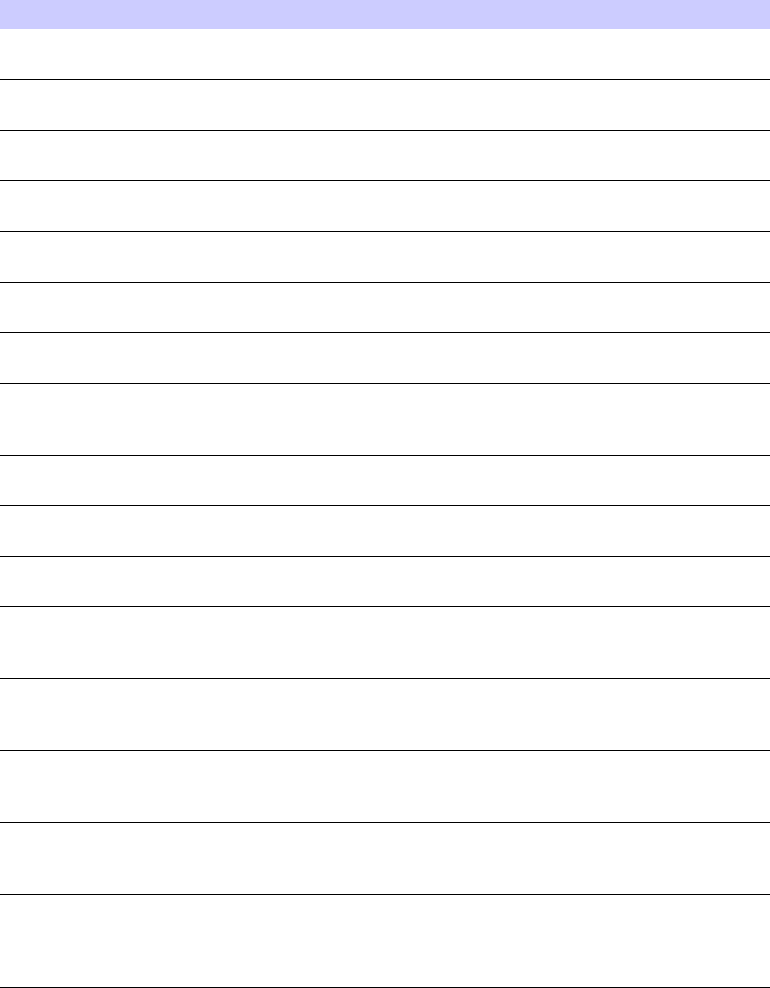
68P09292A81-B 3-11
JUN 2008
Basic Configuration 3
Special Number Tab
The Special Number tab provides a list of special dialing numbers for your VoIP Phone
Service. The Special Number Tab contains the following:
Table 3-13 Special Number Tab
Field or Button Description
Service Provider Contact Number Use this number to contact customer
service for your service provider.
Emergency Number Dial this number to reach local emergency
services.
Redial Dial this number to redial the last number
called.
Blind Call Transfer Dial this number to transfer a call directly
to a third party.
Consultation Call Transfer Dial this number to speak with the third
party before you transfer the call to them.
Call Hold Dial this number to place your current call
on hold.
Automatic Recall Activate Dial this number to call back the number
of the last incoming call.
Automatic Recall Deactivate Dial this number to automatically call
back the last number dialed when that
number becomes available.
Call Forwarding Activate Dial this number to forward your calls to a
different number.
Call Forwarding Deactivate Dial this number to deactivate call
forwarding.
Call Forwarding Busy Activate Dial this number to forward calls to a
different number when the line is busy.
Call Forwarding Busy Deactivate Dial this number to de-activate calls from
forwarding to a different number when
the line is busy.
Call Forwarding Busy Change Number Dial this number to change the phone
number to which calls will be forwarded
when the line is busy.
Call Forwarding No Answer Activate Dial this number to forward calls to a
different number when there is no answer
on Line 1 or Line 2.
Call Forwarding No Answer Deactivate Dial this number to de-activate calls from
forwarding to a different number when
there is no answer on Line 1 or Line 2.
Call Forwarding No Answer Change
Number
Dial this number to change the phone
number to which calls will be forwarded
when there is no answer on Line 1 or Line
2.
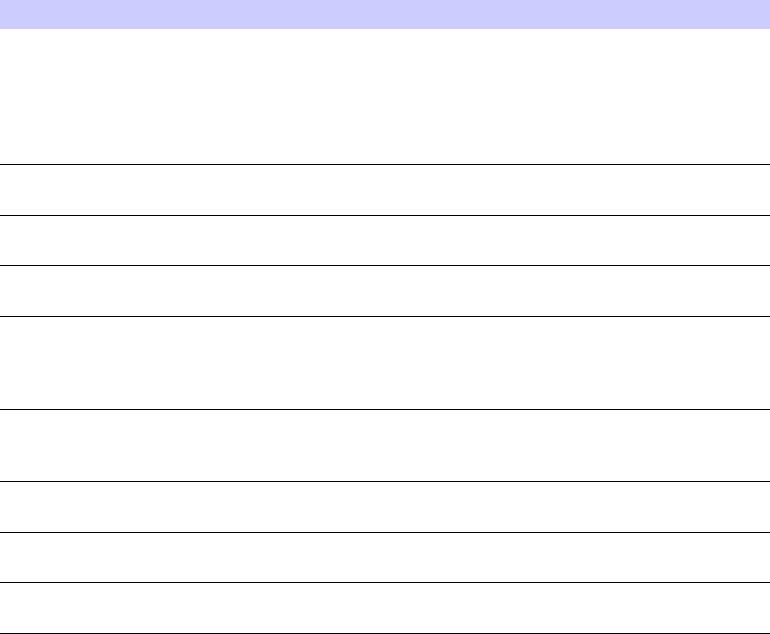
3-12
3Basic Configuration
Automatic Callback Activate Dial this number to hear the most recent
call you missed and to return the call. If
the number is busy, you can hang up.
When the number is available, your phone
will ring. Pick up your phone and the call
will be connected.
Automatic Callback Deactivate Dial this number to de-activate automatic
callback.
Do Not Disturb Activate Dial this number to have calls
automatically routed to voice mail.
Do Not Disturb Deactivate Dial this number to cancel automatic call
routing to voice mail.
Calling Number Delivery Blocking Dial this number to block your number
from appearing on the Caller ID of the
people you call. Your calls may appear as
“Private” or “Anonymous”.
Line Blocking Deactivate Dial this number to unblock your
telephone number from appearing on
Caller ID.
Call Waiting Toggle Dial this number to toggle between call
waiting ON and call waiting OFF.
Anonymous Call Rejection Activate Dial this number to have anonymous calls
rejected.
Anonymous Call Rejection Deactivate Dial this number to allow anonymous calls
to go through.
Table 3-13 Special Number Tab
Field or Button Description
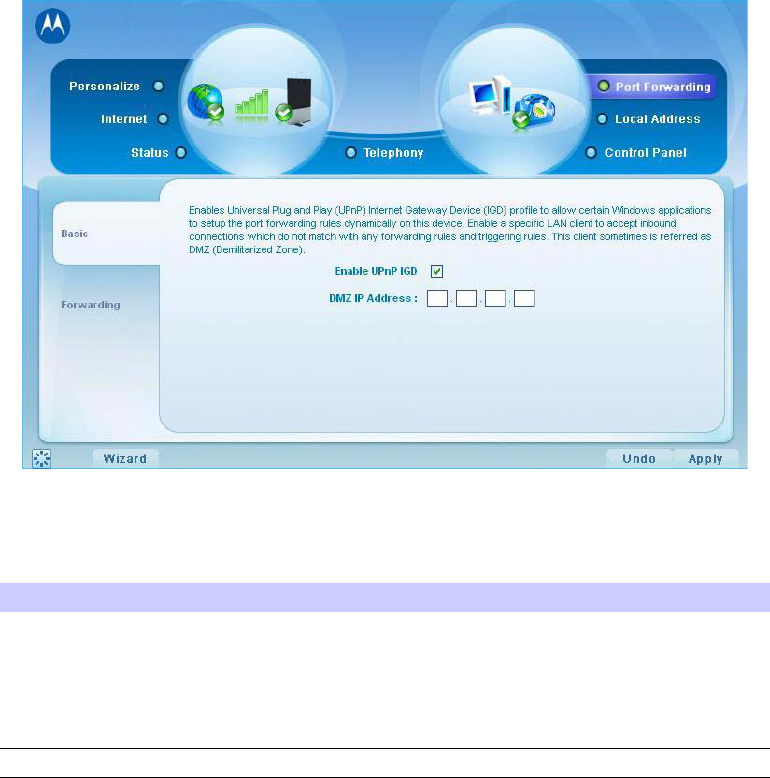
4-1
Advanced Configuration 4
Chapter 4: Advanced Configuration
The Advanced Configuration section describes the Port Forwarding, Local Address,
and Control Panel menus.
Port Forwarding Menu
Port forwarding enables you to direct incoming traffic to specific LAN hosts
(computers on your network) based on the protocol and port number. It is used to play
Internet games or provide local services (such as web hosting) for a LAN group. The
Port Forwarding menu provides the following tabs:
• Basic
• Forwarding
Figure 4-1: Port Forwarding
Be sure to click the Apply button once you have made changes.
Table 4-1 Port Forwarding Menu
Field or Button Description
Enable UPnP IGD Enables the Universal Plug and Play
(UPnP) Internet Gateway Device (IGD)
profile to allow certain Windows
applications to set up the port forwarding
rule dynamically when NAT is enabled on
this device.
DMZ (DeMilitarized Zone) IP Address Enter the DMZ IP Address.
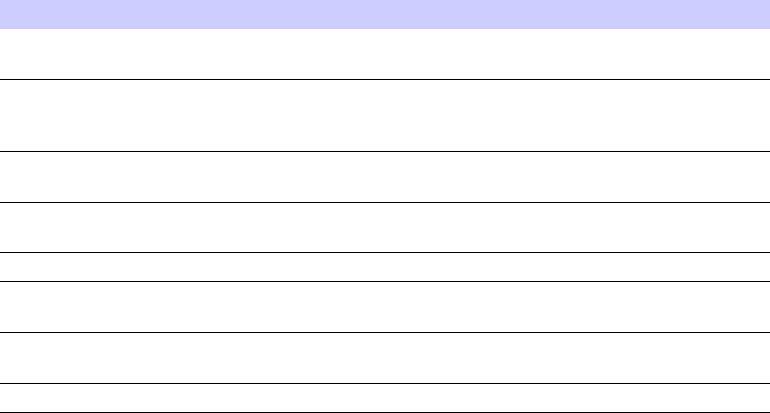
4-2
4Advanced Configuration
Forwarding Tab
Click the ADD button to create additional Port Forwarding rules. The Forwarding tab
contains the following selections:
Be sure to click the Apply button once you have made changes.
Local Address Menu
The Local Address menu allows you to configure your Local Area Network (LAN)
connections.
The Local Address menu provides the following tabs:
• DHCP Server
• Lease Status
• Lease Reservation
Table 4-2 Forwarding Tab
Field or Button Description
Select Select a box when you want to delete the
specific row.
Protocol Select TCP (Transmission Control
Protocol) or UDP (User Datagram
Protocol).
WAN Port Start Enter the beginning port range for
external network access.
WAN Port End Enter the ending port range for external
network access.
LAN IP Address Enter the IP address to host the service.
LAN Port Start Enter the beginning port range for
internal network access.
LAN Port End Enter the ending port range for internal
network access.
Enabled Check to enable specific port forwarding.
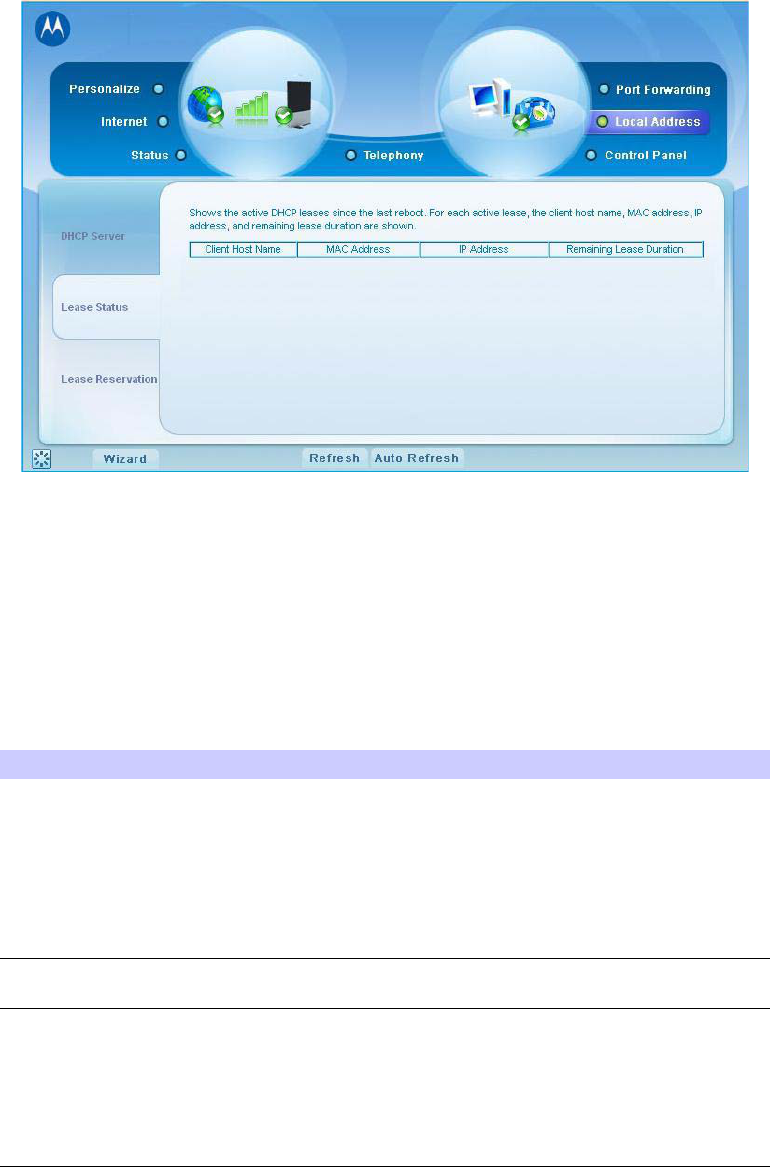
4-3
Advanced Configuration 4
Figure 4-2: Local Address Menu
DHCP Server Tab
The DHCP Server tab enables Dynamic Host Configuration Protocol (DHCP) server
functionality on the LAN, allowing the router to dynamically assign lease IP addresses
to clients that connect to it from the local network. The DHCP Server Tab contains the
following selections:
Table 4-3 DHCP Server Tab
Field or Button Description
Enable DHCP Server If selected, the DHCP server on the
gateway assigns IP addresses to the
computers and other hosts on your
network if they have DHCP enabled. By
default, the gateway server is enabled. If
there is another DHCP server running on
your network (on another router), disable
one of the DHCP servers.
DHCP Server IP Address Enter the default port forwarding LAN
Client IP Address.
DHCP Starting IP Address Sets the first IP address assigned by the
DHCP server, in dotted-decimal format. It
must be greater than the IP address value
of the gateway. For example, if the IP
address of the gateway is 192.168.15.1
(default), the starting IP address must be
192.168.15.2 (or higher).
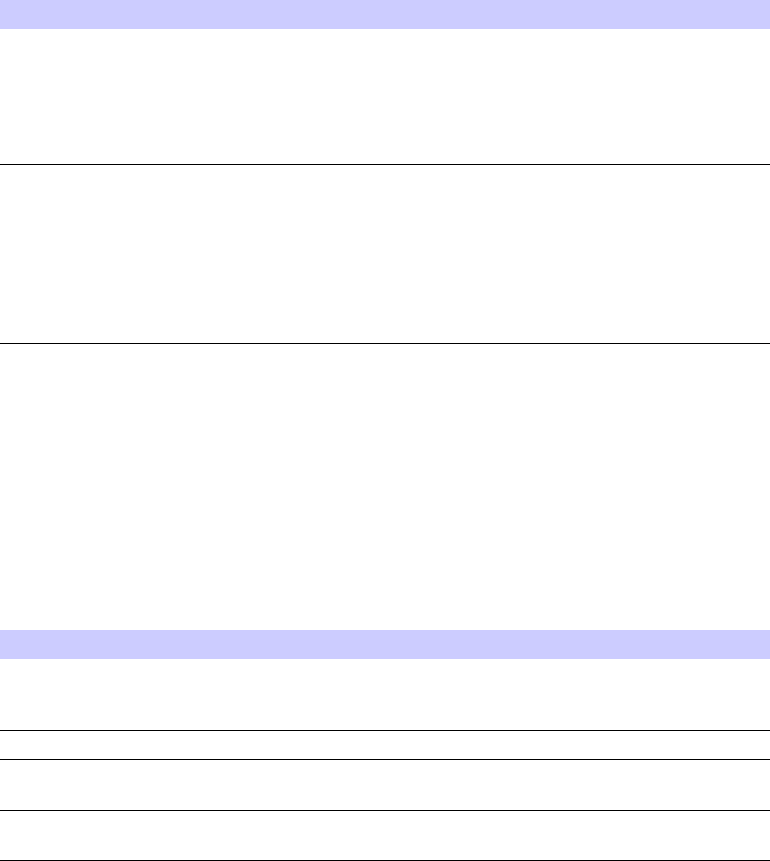
4-4
4Advanced Configuration
Be sure to click the Apply button once you have made changes.
Lease Status Tab
The Lease Status tab in the Local Address menu displays the active DHCP leases since
the last reboot. The Lease Status Tab contains the following selections:
Be sure to click the Apply button once you have made changes.
Lease Reservation Tab
This tab allows you to manage the lease reservation so that the same client receives
the same IP address each time. The Lease Reservation Tab contains the following
selections:
DHCP Ending IP Address Sets the final IP address assigned by the
DHCP server. If the DHCP server runs out
of DHCP addresses, users cannot access
network resources. If this happens,
increase the Ending IP or reduce the
Lease Time.
DHCP Lease Time Sets the time, in seconds, that a network
computer remains connected to the
gateway using its current assigned IP
address. At the end of this time, the DHCP
server renews the lease or assigns the
computer a new IP address. The default is
3600 seconds (one hour). The maximum is
999999 seconds (about 278 hours).
Table 4-3 DHCP Server Tab
Field or Button Description
Table 4-4 Lease Status Tab
Field or Button Description
Client Host Name Displays the client host name. The Name
field is limited to 20 characters (only 5
appear in display).
MAC Address Media Access Control (MAC) address.
IP Address Shows the IP Address for each active
lease.
Remaining Lease Duration Shows the amount of time, in seconds,
remaining in the lease.
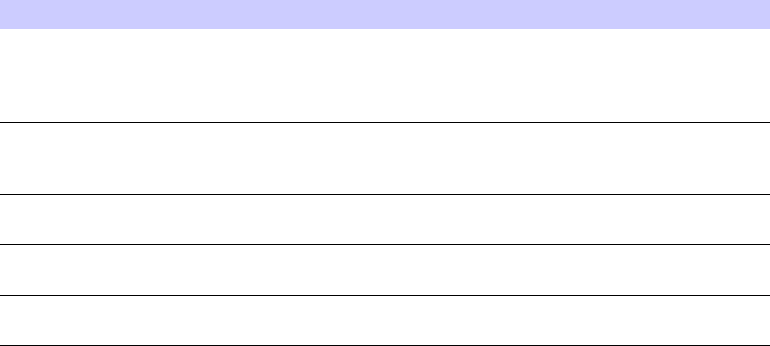
4-5
Advanced Configuration 4
Be sure to click the Apply button once you have made changes.
Control Panel
The Control Panel sections allows you to view/update your software information.
The Control menu provides the following tabs:
•Software
• Certificate
•System
•About
Table 4-5 Lease Reservation Tab
Field or Button Description
Select Select this box if you want to delete an
established lease reservation. Be sure to
click the Delete button once you have
selected the exception to be deleted.
Client Host Name Enter the client host name. The Name
field is limited to 20 characters (only 5
appear in display)
MAC Address Media Access Control (MAC) address.
Enter the MAC address of the device.
IP Address Enter the IP address that you want
assigned to the MAC Address.
Enabled Clicking this box enables the lease
reservation.
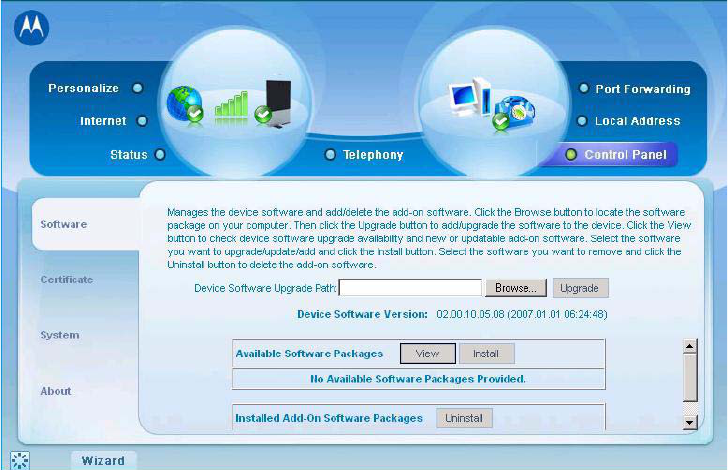
4-6
4Advanced Configuration
Figure 4-3: Control Panel Menu
Software Tab
The Software tab manages the software on your CPE device. It is also where you can
upgrade device software.
Use the BROWSE button to browse your computer for additional software packages.
Once you have located the software package/update you would like to add to your
device, click the Upgrade button.
You should see the available software updates in the “Available Software Packages”
table. If you cannot see the list, click the View button.
Select the software you would like to install and click the Install button.
If you would like to remove software, select the software package you would like to
remove and click Uninstall.
Certificate Tab
The Certificate tab is where you manage the certificates that are stored on the device.
Use the BROWSE button to locate the certificate file on your computer, and then click
the IMPORT button.
Use the REMOVE button to remove any selected certificate(s).
System Tab
This tab allows you to manage additional features of your CPE device
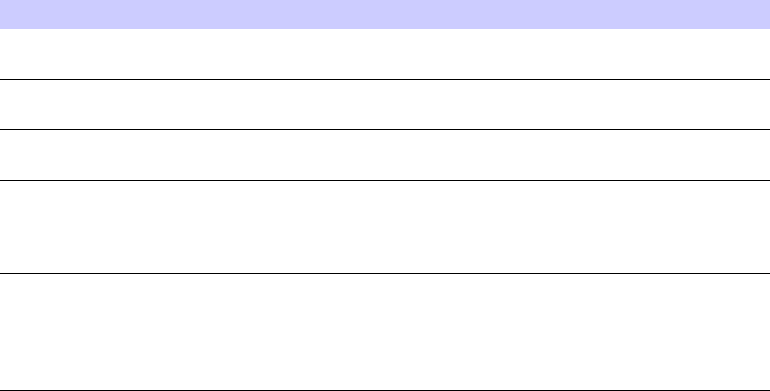
4-7
Advanced Configuration 4
About Tab
The About Tab displays basic properties of your CPE device such as: Product Name,
Model ID, Hardware Version, Serial Number, and the WiMAX MAC Address.
Table 4-6 System Tab
Field or Button Description
Language Used in User Interface Select the desired language for the user
interface. The default language is English.
Enable WiMAX Radio Interface Check this box to enable the WiMAX
Radio Interface.
Enable LED Check this box to enable the LEDs on the
front of your CPE device.
Auto Refresh Interval Enter, in seconds, the interval for status
Auto Refresh. Valid range is 2 seconds -
9999 seconds. The default value is 3
seconds.
Rebootstrap EMS Check this box to reconnect the device
with the EMS.
Only perform this function under the
supervision of a Customer Support
Representative.
4-8
4Advanced Configuration
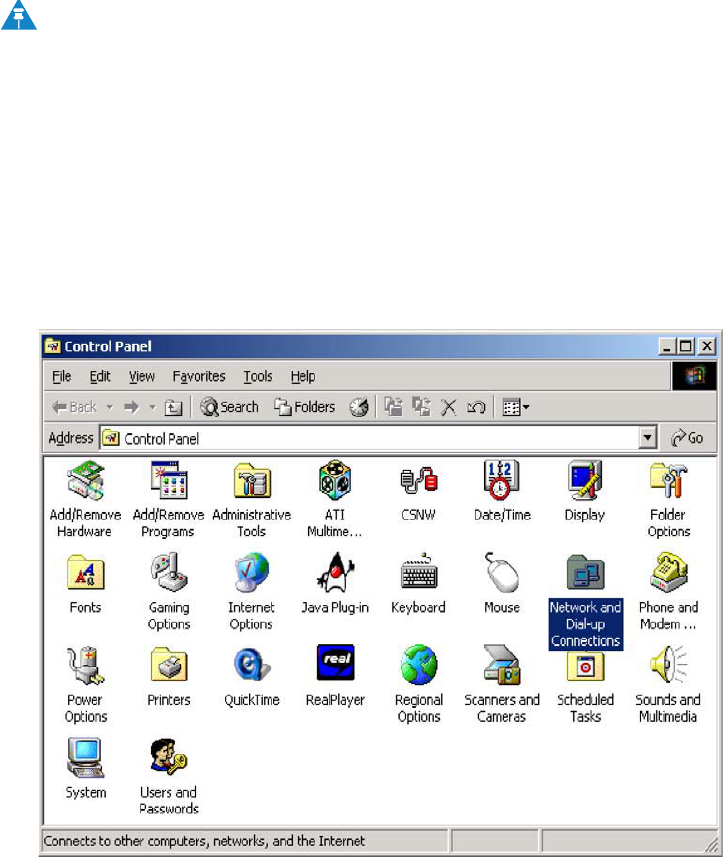
5-1
Configuring TCP/IP 5
Chapter 5: Configuring TCP/IP
This section contains two examples of configuring TCP/IP in a Windows environment.
Most computers already have the TCP/IP configuration enabled. Use the following
procedures to verify that the configuration is set up. Configure all client computers on
your network for TCP/IP (the protocol that controls communication among computers).
Two examples are provided in this document:
• Configuring TCP/IP in Windows 2000
• Configuring TCP/IP in Windows XP
Configuring TCP/IP in Windows 2000
1. On the Windows Desktop, click Start.
2. Select Settings and then Control Panel from the pop-up menus to display the
Control Panel window:
Figure 5-1: Windows Control Panel
3. Double-click the Network and Dial-up Connections icon to display the Network
and Dial-up Connections window:
Follow the instructions in your computer user manual for other Operating
Systems.
NOTE
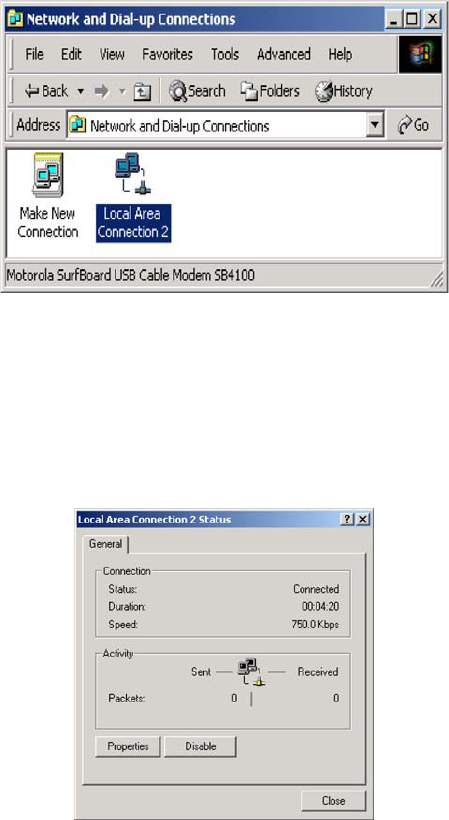
5-2
5Configuring TCP/IP
Figure 5-2: Network and Dial-up Connections
In the steps that follow, a connection number like 1, 2, 3, etc., is a reference that is
displayed on computers with multiple network interfaces. Computers with only one
network interface may only see the label: Local Area Connection.
4. Click Local Area Connection number. The value of number varies from system to
system. The Local Area Connection number Status window is displayed:
Figure 5-3: Local Area Connection
5. Click Properties. Information like the following window is displayed:
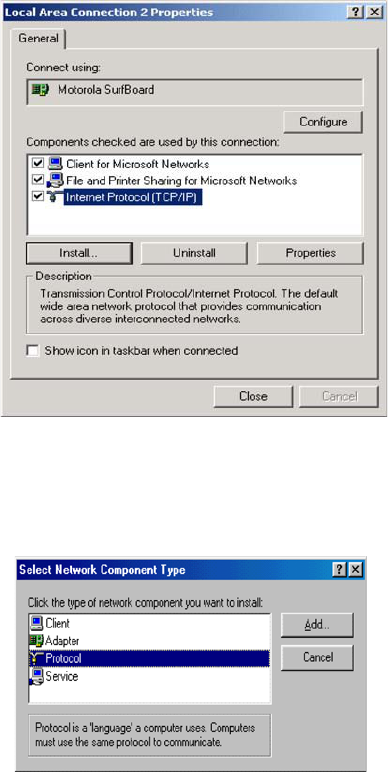
5-3
Configuring TCP/IP 5
Figure 5-4: Properties
6. If Internet Protocol (TCP/IP) is in the list of components, TCP/IP is installed. You
can skip to Step 10.
Figure 5-5: Select Network Connection Type
If Internet Protocol (TCP/IP) is not in the list, click Install. The Select Network
Component Type window is displayed:
7. Click Protocol on the Select Network Component Type window and click Add.
The Select Network Protocol window is displayed:
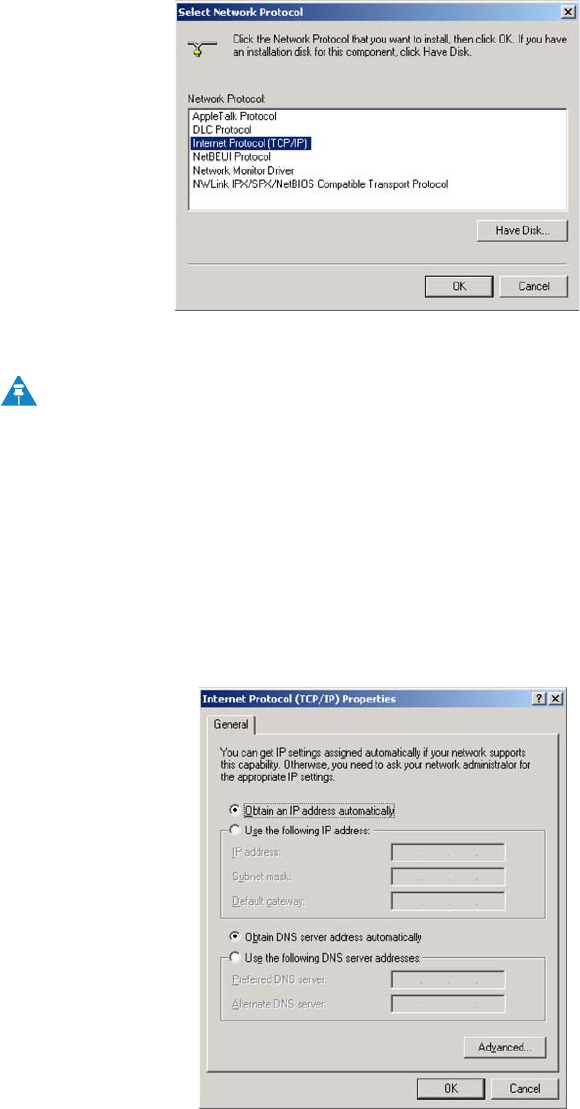
5-4
5Configuring TCP/IP
Figure 5-6: Select Network Protocol
8. Click Internet Protocol (TCP/IP).
9. Click OK. The Local Area Connection number Properties window is re-displayed.
10. Be sure the box next to Internet Protocol (TCP/IP) is checked.
11. Click Properties. The Internet Protocol (TCP/IP) Properties window is displayed:
Figure 5-7: Internet Protocol (TCP/IP) Properties
12. Be sure Obtain IP address automatically and Obtain DNS server address
automatically are selected.
You might have to use the scroll bar to locate the Internet Protocol (TCP/
IP) setting
.
NOTE
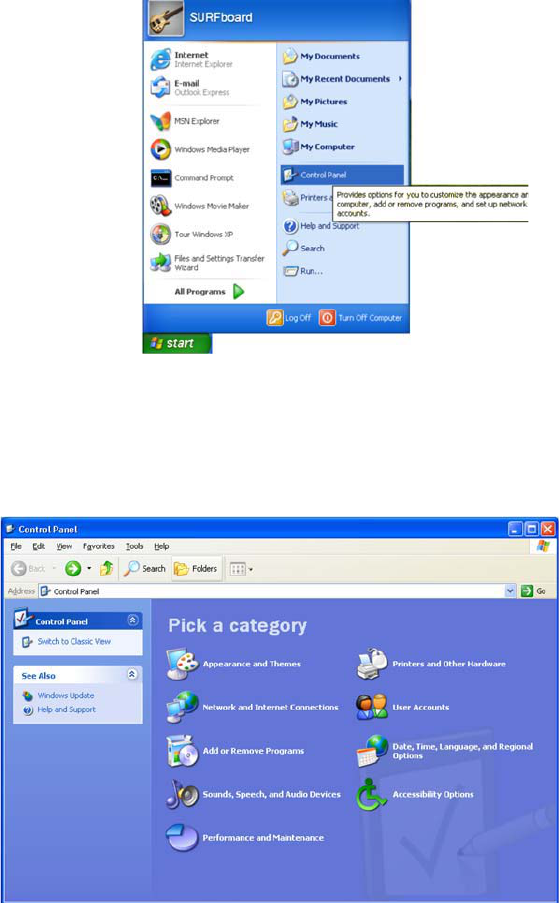
5-5
Configuring TCP/IP 5
13. Click OK to accept the TCP/IP settings.
14. Click Close to close the Local Area Connection number Properties window.
15. Click OK.
16. If prompted to restart the computer and click OK again.
Configuring TCP/IP in Windows XP
1. On the Windows desktop, click Start to display the Start window:
Figure 5-8: Windows XP Start Window
2. Click Control Panel to display the Control Panel window. The display varies,
depending on your Windows XP view options. If the display is a Category view as
shown in Figure 5-9, continue with Step 3. Otherwise, skip to Step 5.
Figure 5-9: Control Panel
3. Click Network and Internet Connections to display the Network and Internet
Connections window:
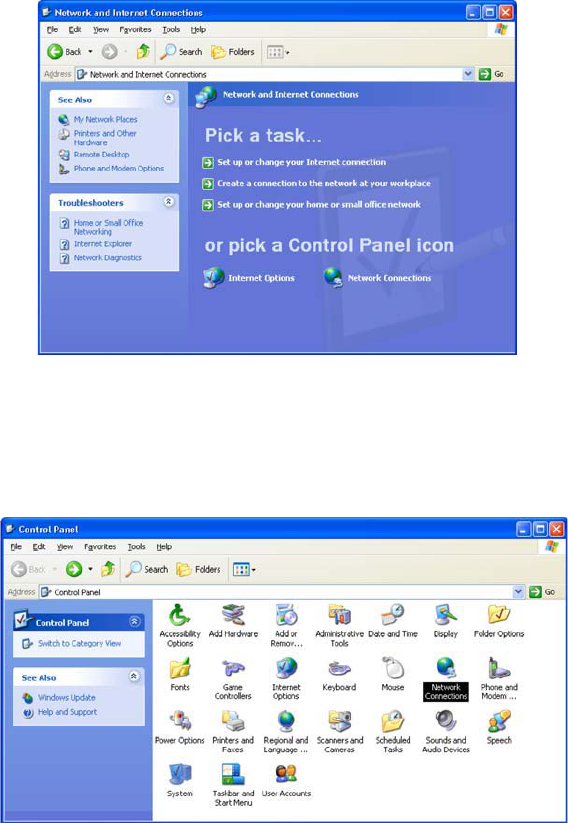
5-6
5Configuring TCP/IP
Figure 5-10: Network and Internet Connections
4. Click Network Connections. Skip to Step 6.
5. If a classic view like Figure 5-11 is displayed, double-click Network Connections
to display the LAN or High-speed Internet connections.
Figure 5-11: Control Panel Classic View
6. Right-click the Local Area Connection. If more than one connection is displayed,
be sure to select the one for your network interface.
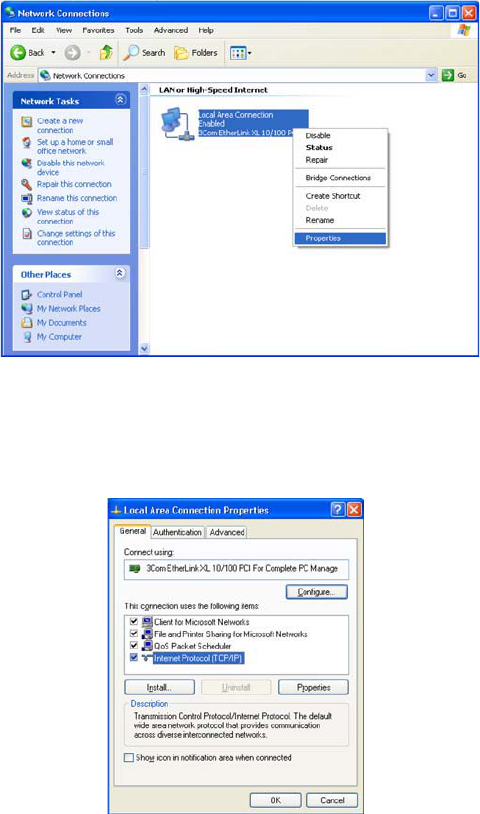
5-7
Configuring TCP/IP 5
Figure 5-12: Network Connections
7. Select Properties from the pop-up menu to display the Local Area Connection
Properties window:
Figure 5-13: Local Area Connection Properties
8. On the Local Area Connection Properties window, select Internet Protocol (TCP/
IP) if it is not selected.
9. Click Properties to display the Internet Protocol (TCP/IP) Properties window.
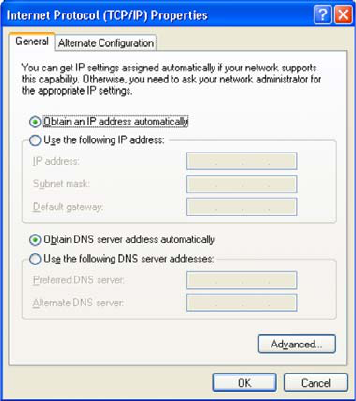
5-8
5Configuring TCP/IP
Figure 5-14: Internet Protocol (TCP/IP) Properties
10. Be sure Obtain IP address automatically and Obtain DNS server address
automatically are selected.
11. Click OK to close the TCP/IP Properties window.
6-1
Troubleshooting 6
Chapter 6: Troubleshooting
Power
• Check that the AC power adapter is properly plugged into the electrical outlet and
into the Desktop CPE.
• Check that the electrical outlet is working.
A Computer Cannot Log On to the CPE
Check that the Ethernet cable is properly connected to the Desktop CPE unit and the
computer.
Cannot Connect to the Internet
• Check the Desktop CPE connection status from the Web Interface, refer to the
Connection Status section to verify the connection status.
• If the Desktop CPE connection is down, and the gateway has not received an IP for
5 minutes to 10 minutes:
- Re-Run the Setup Wizard.
- If the Setup Wizard does not help, then reset the Desktop CPE using the reset
button.
Additional Troubleshooting Help
Contact your service provider for additional help.
6-2
6Troubleshooting
7-1
Important Safety and Legal Information 7
Chapter 7: Important Safety and Legal
Information
Your Motorola WiMAX Wireless Broadband Gateway is designed and tested to comply
with a number of national and international standards and guidelines (listed below)
regarding human exposure to RF electromagnetic energy.
This Product complies with the following RF energy exposure
standards and guidelines:
• United States Federal Communications Commission, Code of Federal Regulations;
47CFR part 2 sub-part J
• American National Standards Institute (ANSI)/ Institute of Electrical and Electronic
Engineers (IEEE) C95 1-2005
• Institute of Electrical and Electronic Engineers (IEEE) C95.1-1999 Edition
• International Commission on Non-Ionizing Radiation Protection (ICNIRP) 1998
• Ministry of Health (Canada) Safety Code 6. Limits of Human Exposure to Radio
frequency Electromagnetic Fields in the Frequency Range from 3 kHz to 300 GHz,
1999
• Australian Communications Authority Radiocommunications (Electromagnetic
Radiation - Human Exposure) Standard, 2003
• ANATEL ANNEX to Resolution No. 303 of July 2, 2002 “Regulation of Limitation of
Exposure to Electrical, Magnetic, and Electromagnetic Fields in the Radio
Frequency Range Between 9 kHz and 300 GHz” and “Attachment to Resolution
#303 from July 2, 2002”
RF Exposure Compliance and Guidelines Operating Instructions
To comply with FCC RF energy exposure requirements, this Gateway desktop
transmitter should be operated at a minimum separation distance of 20 cm from all
persons.
For additional information on exposure requirements or other training information,
visit http://www.motorola.com/rfhealth
FCC Regulatory Information
The 2.5GHz WiMAX device (Model Name: CPEi25725) complies with Part 15 of the
FCC Rules. Operation is subject to the following two conditions: (1) this device may not
cause harmful interference, and (2) this device must accept any interference received;
including interference that may cause undesired operation.
This equipment has been tested and found to comply with the limits for a Class B
digital device pursuant to Part 15 of the FCC rules. These limits are designed to
provide reasonable protection against harmful interference in a residential
installation. This equipment generates, uses, and can radiate radio frequency energy
and, if not installed and used in accordance with the instructions, may cause harmful
interference to radio communications. However there is no guarantee that
interference will not occur in a particular installation, which can be determined by
turning the equipment off and on, the user is encouraged to try to connect the
interference by one of the following measures:
• Reorient or relocate the receiving antenna.
• Increase the separation between the equipment and receiver.
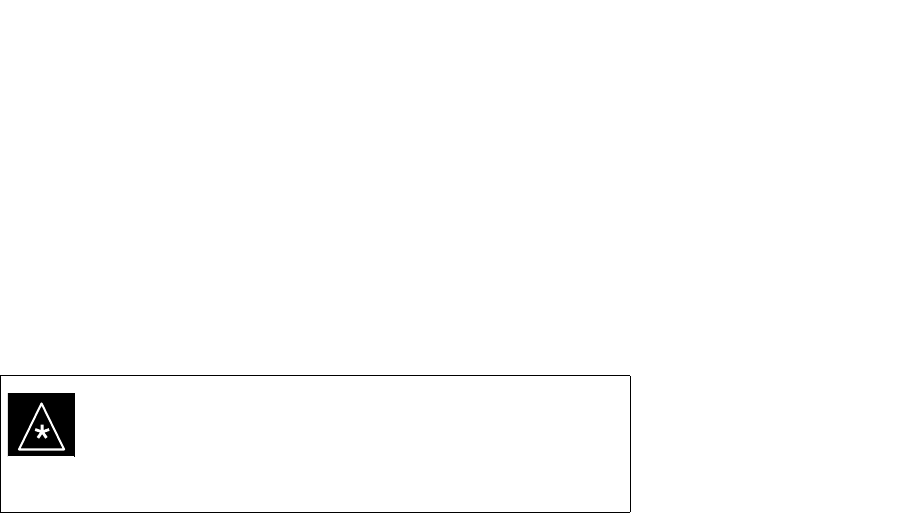
7-2
7Important Safety and Legal Information
• Connect the equipment into an outlet on a circuit different from that to which the
receiver is connected.
• Consult the dealer or an experienced radio/TV technician for help.
This Gateway desktop transmitter must not be co-located or operating in conjunction
with any other antenna or transmitter.
FCC Caution: Any changes or modifications not expressly approved by the party
responsible for compliance could void the user’s authority to operate this equipment.
Industry Canada Statement
2.5GHz WiMAX device (Model Name: CPEi25725) complied with RSS-Gen and RSS-
193 of the Industry Canada Rules.
Operation is subject to the following two conditions:
• This device may not cause interference and
• This device must accept any interference, including interference that may cause
undesired operation of the device.
This device has been designed to operate with an antenna having a maximum gain of 7
dBi. Antenna having a higher gain is strictly prohibited per regulations of Industry
Canada. The required antenna impedance is 50 ohms. To reduce potential radio
interference to other users, the antenna type and its gain should be so chosen that the
equivalent isotropically radiated power (E.I.R.P) is not more than that permitted for
successful communications.
This Class B digital apparatus complies with Canadian ICES-003.
Cet appariel numérique de la class B est conforme à la norme NMB-003 du Canada.
C
Radiation Exposure Statemen
IMPORTANT
This equipment complies with IC radiation exposure limits
set forth for an uncontrolled environment. This equipment
should be installed and operated with a minimum distance
of 20cm between the radiator and you.
5

7-3
Important Safety and Legal Information 7
Caring for the Environment
The following information is provided to enable regulatory compliance with the
European Union (EU) Directive 2002/96/EC Waste Electrical and Electronic
Equipment (WEEE) when using Motorola Networks equipment in EU countries.
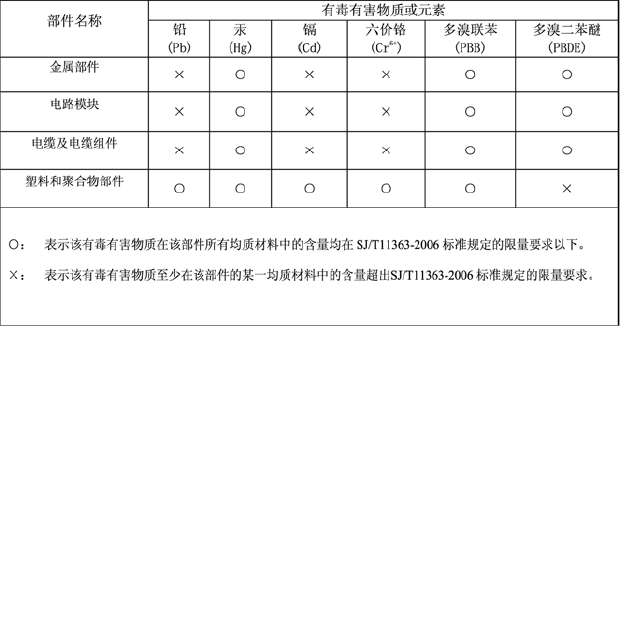
7-4
7Important Safety and Legal Information
In the EU, Motorola Networks in conjunction with a recycling partner will ensure that
equipment is collected and recycled according to the requirements of EU
environmental law.
Disposal of Motorola Networks Equipment in Non-EU countries
In non-EU countries, dispose of Motorola Networks equipment in accordance with
national and regional regulations.
CMM Disclosure
The China Management Methods (CMM) Disclosure Table is intended only to
communicate compliance with China requirements; it is not intended to communicate
compliance with EU RoHS or any other environmental requirements.
Disposal of Motorola Equipment in EU Countries
This product is compliant with the requirements of the European Union Restriction of
Hazardous Substances (EU RoHS) directive.
Please do not dispose of Motorola Networks equipment in landfill sites.
7-5
Important Safety and Legal Information 7
Copyrights and Trademarks
Notice
While reasonable efforts have been made to assure the accuracy of this document,
Motorola, Inc. assumes no liability resulting from any inaccuracies or omissions in this
document, or from use of the information obtained herein. The information in this
document has been carefully checked and is believed to be entirely reliable. However,
no responsibility is assumed for inaccuracies or omissions. Motorola, Inc. reserves the
right to make changes to any products described herein and reserves the right to
revise this document and to make changes from time to time in content hereof with no
obligation to notify any person of revisions or changes. Motorola, Inc. does not assume
any liability arising out of the application or use of any product, software, or circuit
described herein; neither does it convey license under its patent rights or the rights of
others.
It is possible that this publication may contain references to, or information about
Motorola products (machines and programs), programming, or services that are not
announced in your country. Such references or information must not be construed to
mean that Motorola intends to announce such Motorola products, programming, or
services in your country.
Copyrights
This instruction manual, and the Motorola products described in this instruction
manual may be, include or describe copyrighted Motorola material, such as computer
programs stored in semiconductor memories or other media. Laws in the United
States and other countries preserve for Motorola and its licensors certain exclusive
rights for copyrighted material, including the exclusive right to copy, reproduce in any
form, distribute and make derivative works of the copyrighted material. Accordingly,
any copyrighted material of Motorola and its licensors contained herein or in the
Motorola products described in this instruction manual may not be copied,
reproduced, distributed, merged or modified in any manner without the express
written permission of Motorola. Furthermore, the purchase of Motorola products shall
not be deemed to grant either directly or by implication, estoppel, or otherwise, any
license under the copyrights, patents or patent applications of Motorola, as arises by
operation of law in the sale of a product.
Usage and Disclosure Restrictions
License Agreements
The software described in this document is the property of Motorola, Inc. and its
licensors. It is furnished by express license agreement only and may be used only in
accordance with the terms of such an agreement.
Copyrighted Materials
Software and documentation are copyrighted materials. Making unauthorized copies
is prohibited by law. No part of the software or documentation may be reproduced,
transmitted, transcribed, stored in a retrieval system, or translated into any language
or computer language, in any form or by any means, without prior written permission
of Motorola, Inc.
7-6
7Important Safety and Legal Information
High Risk Materials
Components, units, or third-party products used in the product described herein are
NOT fault-tolerant and are NOT designed, manufactured, or intended for use as on-
line control equipment in the following hazardous environments requiring fail-safe
controls: the operation of Nuclear Facilities, Aircraft Navigation or Aircraft
Communication Systems, Air Traffic Control, Life Support, or Weapons Systems (High
Risk Activities). Motorola and its supplier(s) specifically disclaim any expressed or
implied warranty of fitness for such High Risk Activities.
Trademarks
MOTOROLA and the Stylized M Logo are registered in the US Patent & Trademark
Office. All other product or service names are the property of their respective owners.
© Motorola, Inc., 2009